15 September 2023
By Maynard Paton
FY 2023 results summary for System1 (SYS1):
- A much stronger H2 versus the unsatisfactory H1, with disgruntled shareholders and proposed board changes prompting management to lift Q4 Data/Data-led revenue by a bumper 81%.
- New partnerships and customer wins support the H1 strategic review, although partnership revenue and customer numbers remain frustratingly inconsistent and unclear.
- Progress at Test Your Idea/Brand continues to be slow, with rival Zappi taking market share and an upcoming marketing course raising fresh doubts about management’s Data-platform focus.
- Vague signs of favourable ‘operational gearing’ may now be emerging, although regular adjustments and capitalised IT still complicate reported earnings.
- A deeply divided shareholder base and languishing share price may leave the door open for corporate activity, with global market-research groups hopefully able to recognise significant sales/cost benefits. I continue to hold.
Contents
- News links, share data and disclosure
- Why I own SYS1
- Results summary
- General meeting and deeply divided shareholders
- Revenue and profit
- Strategic review and ‘unmatchable’ predictiveness
- Data versus Consultancy
- Test Your Ad versus Test Your Idea/Brand
- Orlando Wood and Uncensored CMO
- Partnerships
- Clients and customers
- Sales and marketing
- Zappi
- Financials
- Valuation
- What next for larger shareholders?
News links, share data and disclosure
- Annual results, presentation and webinar published/hosted 01-02 August 2023
- My Q&A with management hosted 04 August 2023
- Q1 2024 trading update published 13 July 2023
Share price: 215p
Share count: 12,678,829
Market capitalisation: £27m
Disclosure: Maynard owns shares in System1. This blog post contains SharePad affiliate links.
Why I own SYS1
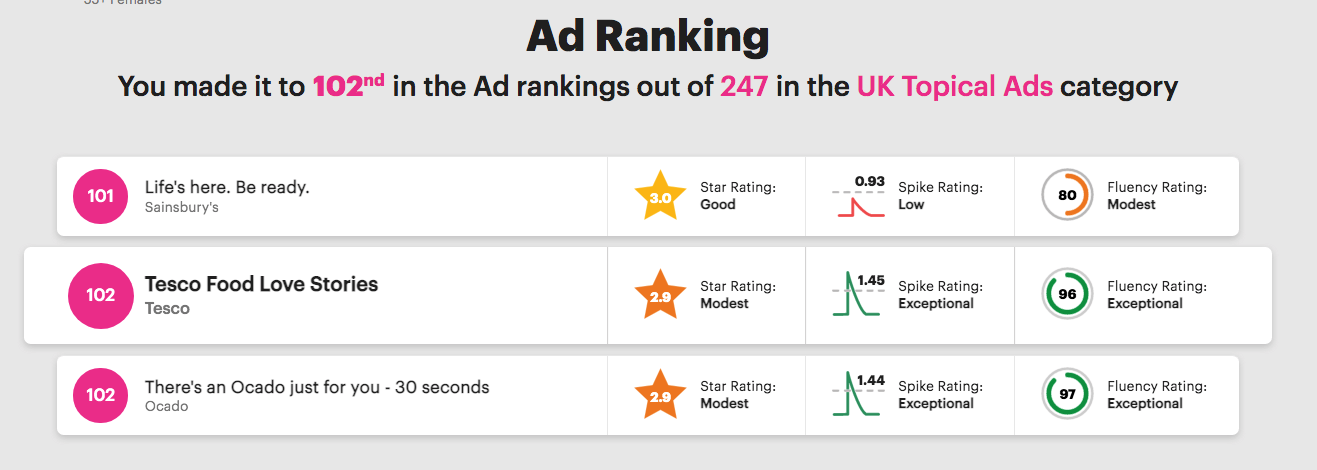
- Research specialist that forecasts the success of television adverts, with progress resting upon “unmatchable predictiveness” backed by “unique IP” delivered at “market-beating speed and value” through a “world-class product suite“.
- Transition from bespoke consultancy towards ‘scalable’ data services should create a much more valuable business with larger customers attracted at a lower cost.
- A 42% shareholder protest against management may open the door to corporate activity, with a former director having offered to refocus the business and exit through an £8 per share trade sale.
Further reading: My SYS1 Buy report | All my SYS1 posts | SYS1 website
Results summary
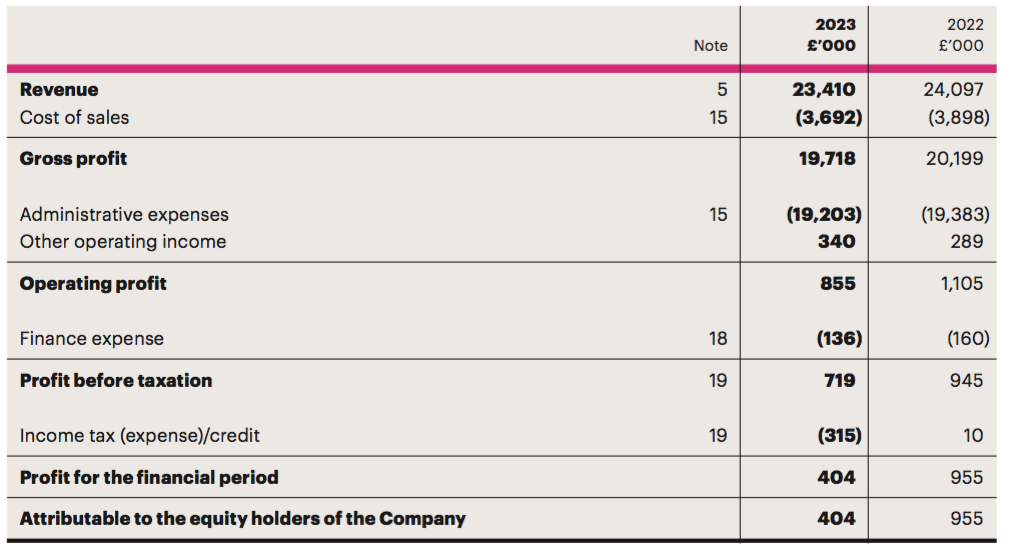
General meeting and deeply divided shareholders
- This FY 2023 did not really mention April’s general meeting (GM) and SYS1’s disgruntled shareholders.
- To recap, SYS1 undertook a strategic review during the preceding H1 and presented the details during February’s Capital Markets Day.
- But former SYS1 executives Stefan Barden and James Geddes were unconvinced by the strategic review and requisitioned the GM to implement various board changes:
“The board changes proposed by Stefan Barden and James Geddes are to:
(i) retire Rupert Howell as Chairman and a Non-Executive Director of the Company;
(ii) elect Stefan Barden as Executive Chairman and a Director of the Company;
(iii) retire Philip Machray as a Non-Executive Director of the Company; and
(iv) re-elect John Kearon as a Director of the Company but moving into a Non-Executive capacity.”
- Mr Barden believed SYS1 was not exploiting its full ‘platform’ potential with founder John Kearon maintaining an executive role.
- In particular, Mr Barden felt SYS1’s transition from bespoke consultancy to marketing-data specialist had become hampered by a return to the creative side of advertising. Mr Barden told me earlier this year:
“System1 should be selling marketing predictions. What System1 should not be doing is selling advertising creativity. And this is the fundamental issue, the creativity side has taken over and pushed the platform thinking out...
To maximise shareholder value, System1 should be the definitive decision-making platform that delivers better predictions…
System1 should be talking about its marketing predictions being the best, the cheapest and the quickest. I now believe that the only way for System1 to become a global number-one platform is for there to be a clear shareholder mandate.“
- The proposed board changes were rejected at the April GM by 58% to 42% of the votes cast.
- The GM voting highlighted SYS1’s deeply divided shareholder base, which can be split between:
- Mr Kearon and supportive shareholders (48%);
- Mr Barden and other unhappy shareholders (35%), and;
- Shareholders that did not cast a GM vote (17%).
- Note that Mr Kearon’s 22% shareholding ensured the GM vote went his way, although his endorsement by other shareholders — 26% of the share count — was less than the 35% that voted for the board changes.
- This FY said the shareholder dissatisfaction had been “considered carefully“:
“As a board we are conscious of our fiduciary duty to all stakeholders including customers, employees and shareholders. Over the year we were satisfied with our engagement with customers and colleagues. However, the share price performance in the period and the dissatisfaction expressed by a number of shareholders in the lead up to the AGM and the 21 April 2023 general meeting has been listened to and considered carefully. We will continue to engage with all shareholders, including those who voted in favour of the resolutions, to improve alignment on the Group’s strategy and increase shareholder value.”
- The FY webinar mentioned the GM had prompted extra reporting disclosure:
“And specifically on what we’re doing differently, we’re having more engagement with shareholders including this Investor Meet session. We’re providing greater disclosure on our quarterly trading updates on platform revenue for example, and extra information on cost and cash flow in this presentation.”
- Part of the “more engagement with shareholders” included my own management Q&A session after these FY results.
- The GM voting created a new risk within the 2023 annual report:
“POTENTIAL IMPACT: Shareholder relations: the company’s plans could be opposed by significant shareholders
MITIGATION: The company holds comprehensive investor one-on-one and group meetings in roadshows after the full-year and interim results are announced. In addition, quarterly trading updates provide an opportunity to engage with shareholders who follow the company closely.”
- That mitigation does not feel sufficient to me.
- The very best mitigation to prevent any shareholder opposition is to deliver the full level of revenue and profit the group’s services are capable of.
- Management disclosed during my Q&A the GM had “cost a lot of money“, all of which was expensed during this FY.
- Management also disclosed during my Q&A the requisition “did not do any harm” to the Q4 2023 outcome (see Data versus Consultancy).
- AGM voting later this month will reveal whether this FY’s performance has sweetened or soured the mood among shareholders. Every director is up for re-election.
Revenue and profit
- This FY confirmed the stronger H2 that was anticipated within April’s GM notice…
“For example, in respect of the Predict Your (data) and Improve Your (data-led consultancy) offering only:
…
* H2 FY23 looks likely to deliver over 30% revenue growth vs H2 FY22
* Q4 FY23 is expected to produce double digit % revenue growth vs Q3 FY23, and we expect Q4 FY23 to deliver 50% higher revenue than Q4 FY22
…
We have grown the Predict Your and Improve Your revenue from launch in H2 FY21 to expected revenue of over £16m in FY23. However, this has been more than offset by a decline in the bespoke consultancy business from £25m to circa £6m in the same timeframe. “
“The improved revenue performance in H2 is expected to bring a return to profitability at adjusted and statutory levels for H2and also for the year as a whole, based on the unaudited management accounts, and the Board now anticipates that profit for the year ended 31 March 2023 will slightly exceed its previous expectations. As indicated in the 23 February 2023 trading update, there was a cash inflow during Q4, resulting in year-end net cash of £5.7m.“
- Matters were complicated slightly by SYS1 restating its revenue numbers between April and this FY.
- SYS1 initially claimed FY 2023 showed Data revenue of £13.7m, Data-led consultancy revenue of £3.5m and old bespoke Consultancy revenue of £6.2m:
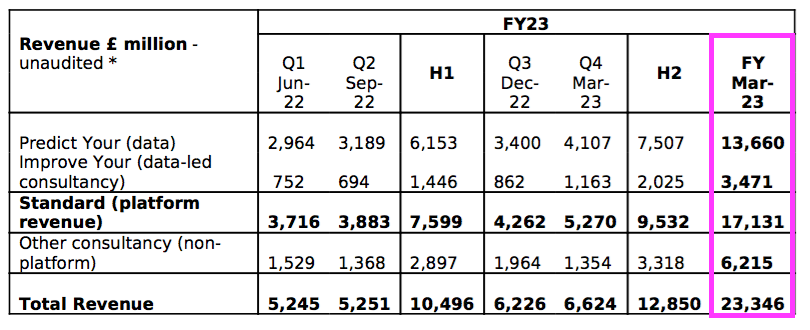
- But these results declared Data revenue of £14.1m, Data-led consultancy revenue of £3.3m and old bespoke Consultancy revenue of £6.0m:

- Total FY 2023 revenue was therefore £23.4m versus the £23.3m cited during April:
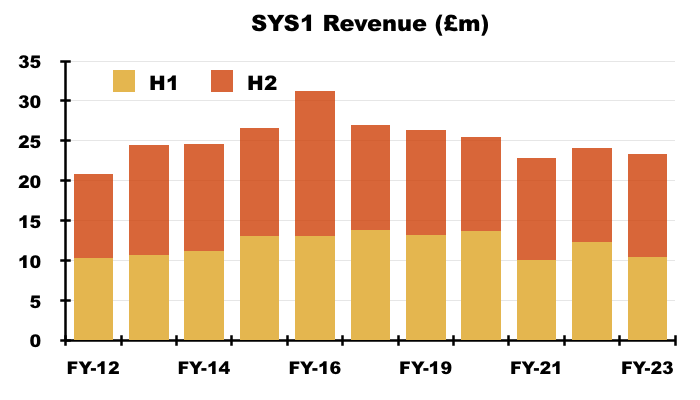
- Taking the restated FY revenue figures, Data/Data-led consultancy gained:
- 81% to £5.5m during Q4 2023;
- 45% to £9.8m during H2 2023, and;
- 40% to £17.4m during FY 2023:
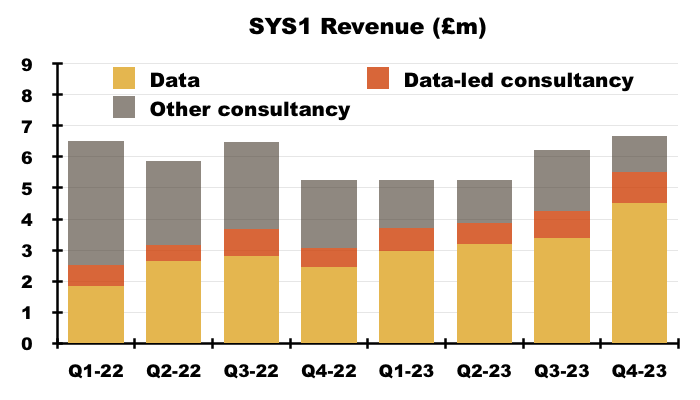
- FY revenue from bespoke Consultancy dived 48% to £6.0m.
- Total FY revenue fell 3%, although total H2 revenue gained 10% to £12.9m to register the best H2 revenue effort since H2 2019 (£13.7m).
- Note that H2 2023 revenue and FY 2023 revenue were lower than the respective levels struck ten years ago (H2 2013: £13.7m, and FY 2013: £24.5m).
- SYS1 did indeed “bring a return to profitability at adjusted and statutory levels for H2 and also for the year as a whole“:
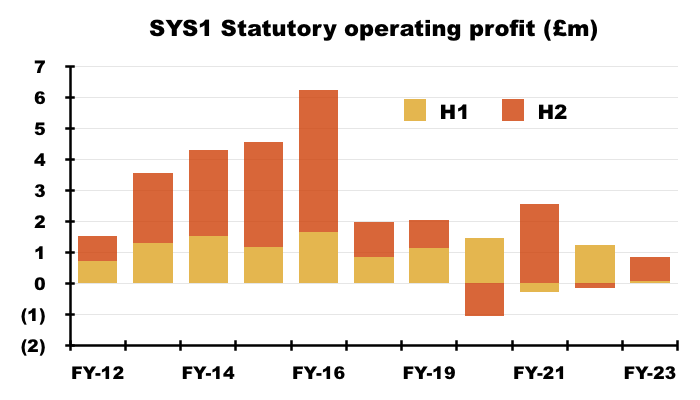
- Mind you, the income statement included SYS1’s usual array of adjustments:
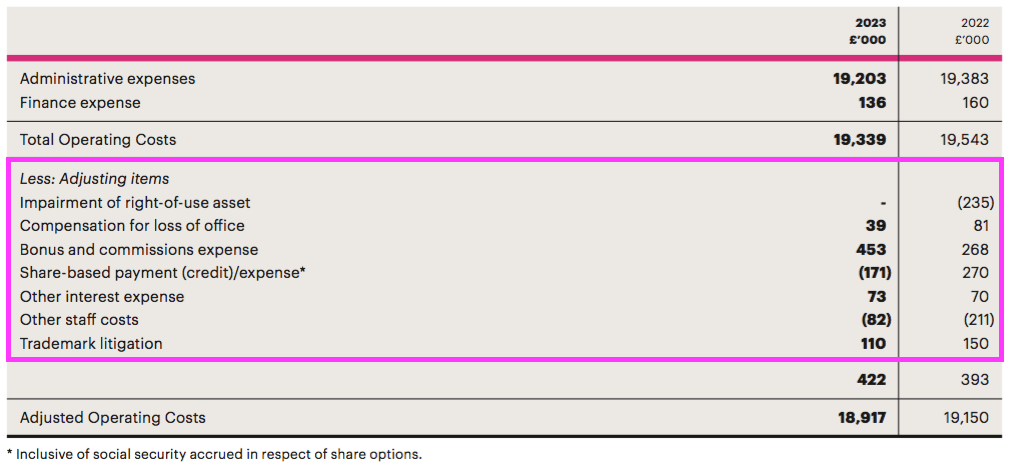
- SYS1 claimed its adjusted figures exclude items that “impede easy understanding of underlying performance” (see Financials).
- SYS1’s results have not offered an “easy understanding of underlying performance” for some time.
- Adjusting items featured during FYs 2021 and 2022…
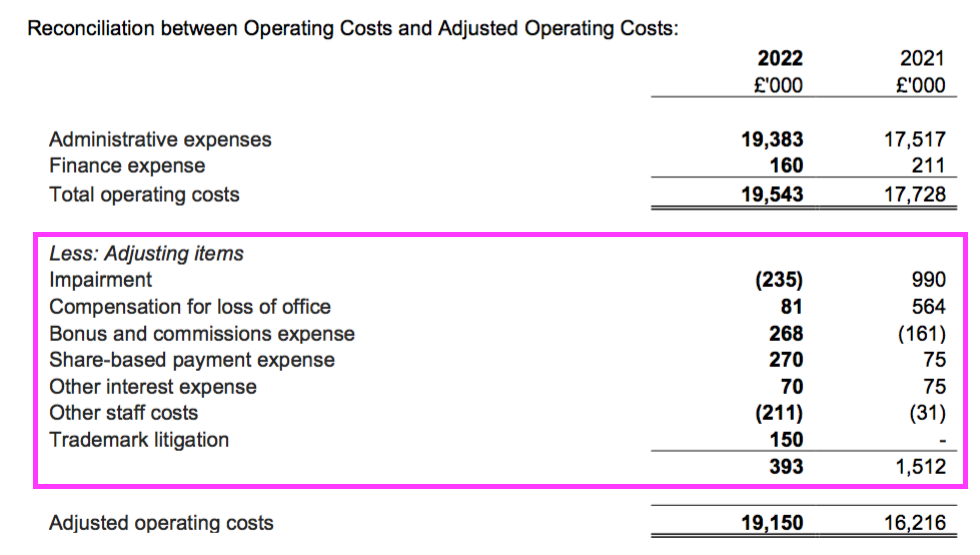
- …while significant AdRatings costs were segmented for FYs 2019 and 2020:

- This FY witnessed SYS1 return to capitalising software development, with a net £1.1m spent on new systems that bypassed the income statement (see Financials).
- SYS1 previously capitalised IT spend of £1.4m for AdRatings during FYs 2019 and 2020, only for it all to be written off following insufficient sales.
- History may therefore suggest SYS1 should expense all software development, and this FY’s £0.8m adjusted pre-tax profit should arguably have been reported as a £0.3m loss.
- My sums indicate H2 delivered an adjusted pre-tax profit of £1.4m…
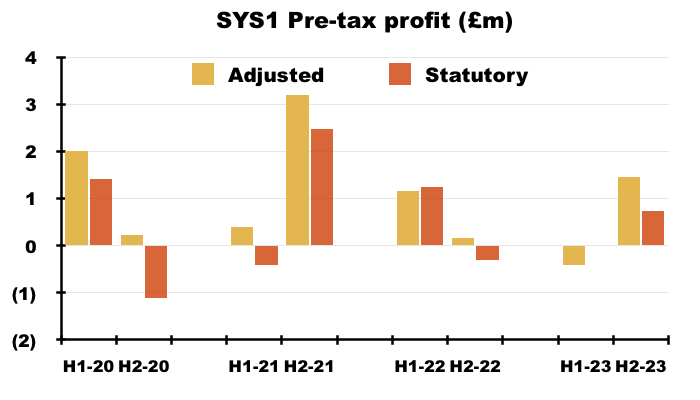
- …although I calculate that £1.4m was supported almost entirely by H2 adjustments (c£0.7m), capitalised IT expenses (c£0.6m) and other income (c£0.1m), leaving the business seemingly operating at breakeven.
- At least the £5.7m net cash position signalled during April was confirmed within this FY without restatement or adjustment.
Strategic review and ‘unmatchable’ predictiveness
- This FY reiterated the outcome of the H1 strategic review, which concluded SYS1 should devote greater attention to:
- The group’s ‘unique selling proposition of predictiveness’;
- Digital ads;
- The world’s largest advertisers;
- Partnerships with media groups, such as the existing tie-ups with ITV and LinkedIn;
- Partnerships with industry agencies, such as Omnicom/BBDO, and;
- The United States.
- SYS1 presented its strategic review in more detail during February’s Capital Markets Day.
- On the unique selling proposition, this FY reiterated the group’s competitive position was based upon “unmatchable” ad-testing predictions delivered through a “world-class” IT platform:
“System1 offers unmatchable predictiveness alongside market-beating speed and value…
We have continued to build out our world-class platform and product suite, translating our unique IP into predictions and improvements for our customers…
These predictions are delivered at world-class speed, ready for customers within 24 hours and offered at incredible value pricing. This creates an automated marketing decision-making platform to delight our customers and create competitive advantage, enabling System1 to build out significant market share.“
- The mystery to shareholders — and which essentially led to April’s GM — is why this “unmatchable predictiveness” backed by “unique IP” and “world-class” service has not yet translated into worthwhile earnings.
“Let me finish with a question that I have pondered with System1 for many years:
“If the company’s products and services are so world class — why then has the company performed so poorly?”
I am still looking for answers to this question, but the share price always tells a story. The £2 price is back to where it was more than ten years ago, and the common executive denominator throughout all that time is Mr Kearon.
If the share-price action is telling me anything, it is Mr Kearon should step aside and allow Mr Barden the opportunity to finally maximise the group’s world-class products.”
- This FY did not reveal any huge developments within the areas of focus identified by the strategic review.
- This FY did confirm various new partnerships had expanded SYS1’s coverage within digital, mobile and outdoor advertising:
“Our new partnerships are focussed on increasing global presence in specific channels and each launched with joint thought leadership content to promote the partnership and grow System1’s fame.
• Pinterest (digital advertising in Europe)
• Finecast (addressable TV advertising US, UK,Canada, Australia)
• Teads (mobile advertising US and UK)
• JCDecaux (out-of-home advertising US and UK)

- July’s Q1 update then said the new partnerships were working well:
“The Board is encouraged by the development of these new partnerships and the adoption of System1’s methodology across further advertising formats.”
- I note partnership income was not disclosed for this FY 2023 (see Partnerships).
- This FY repeated the US progress mentioned within April’s Q4 update:
“Excellent progress was made in Q4 where we won new mandates from 3 of the country’s 25 biggest advertising spenders, including the largest.”
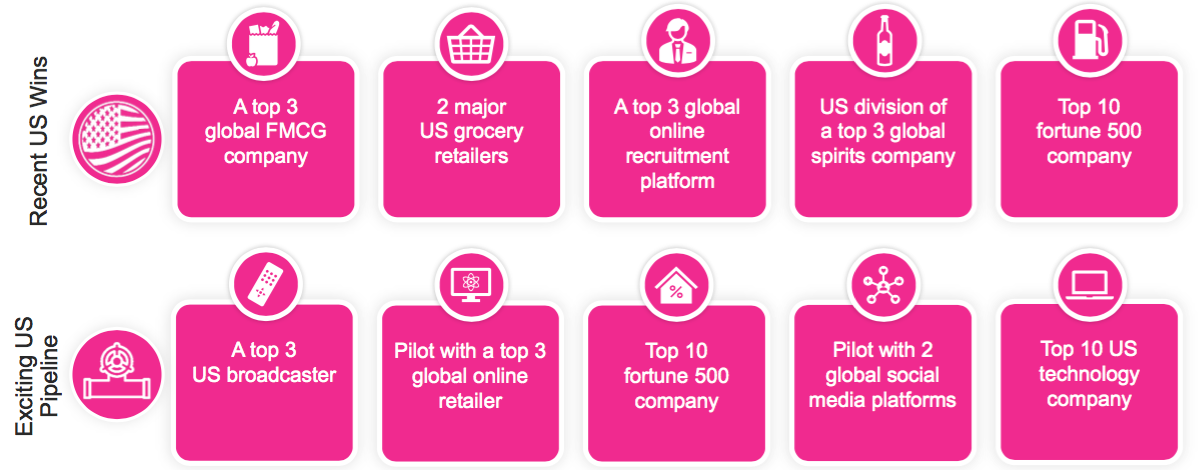
- July’s Q1 update then noted at least four new US customers:
“The Company scored a series of new customer wins in the quarter.In the US, these included one of the world’s largest publicly traded international oil and gas companies, a worldwide employment website, a global chocolate manufacturer, and a significant provider of search and advertising services on the internet.“
- Revenue from the Americas represented 40% of group revenue during this FY, with the proportion at 42% for H2:
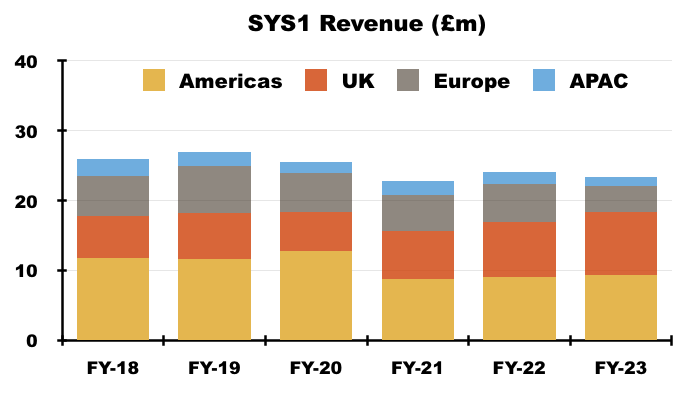
- Management said during my Q&A the United States:
- Represented the “vast majority” of Americas revenue;
- Should become SYS1’s “biggest growth engine and fastest growth engine“, and;
- Now operates with a “solid” team that is “really working well“.
- The ‘Rule of 40’ target introduced by the strategic review was maintained for this FY:
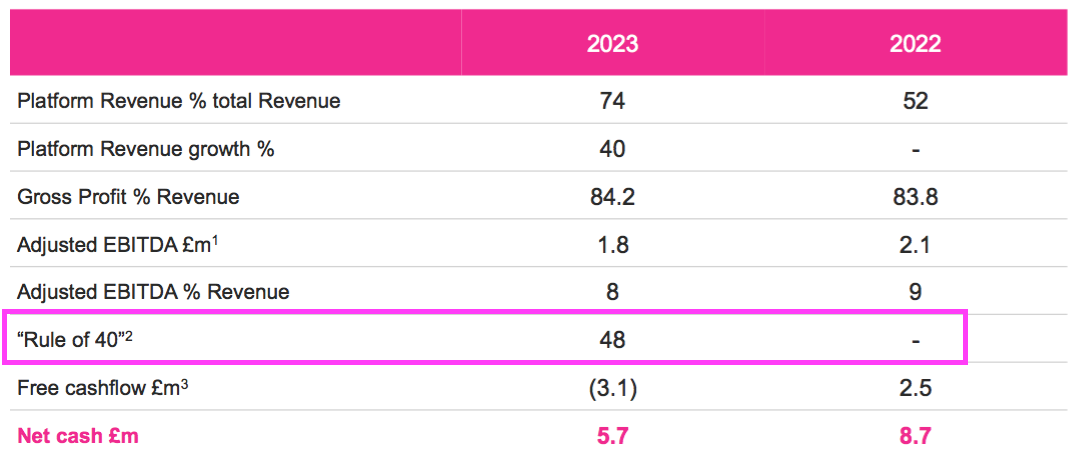
- The Rule of 40 figure is derived by adding Data/Data-led revenue growth to the adjusted total Ebitda margin…
- …although that calculation could be flattered by excluding old bespoke Consultancy revenue but including old bespoke Consultancy Ebitda (see Data versus Consultancy).
- The £1 billion market-cap ambition first trumpeted within the 2021 annual report and then watered down within the 2022 annual report still enjoyed a mention within the 2023 annual report:

- Management said during my Q&A there was “space in the market [for the company] to become much larger” and the £1 billion market-cap ambition remained a “great aspiration“.
- Management also noted during my Q&A the absence of the £1 billion goal within the FY results narrative and FY powerpoint “did not mean we are less ambitious“.
Data versus Consultancy
- This FY went some way to emphasise the “execution” of SYS1’s strategy:
“FY23 has truly been a year of 2 halves as we have moved from a period of design and transition to one of relentless commercial execution.”
…
“With renewed strategic focus in H2, we delivered £12.9m revenue, up 10% vs the second half of FY22, as we executed a refined go-to-market strategy, with a realigned Executive team and clarity of mission.”
…
“We are dedicated to creating a performance-based culture, relentlessly focussed on execution against our strategy.“
- That strategy was defined during the preceding H1 and validated the shift from supplying bespoke consultancy work to providing automated data services.
- Data products are led by Test Your Ad…
- …which was launched during April 2020 and allows customers to upload proposed adverts to SYS1 and receive a report within 24 hours based upon the verdict of an online panel (example pdf here):
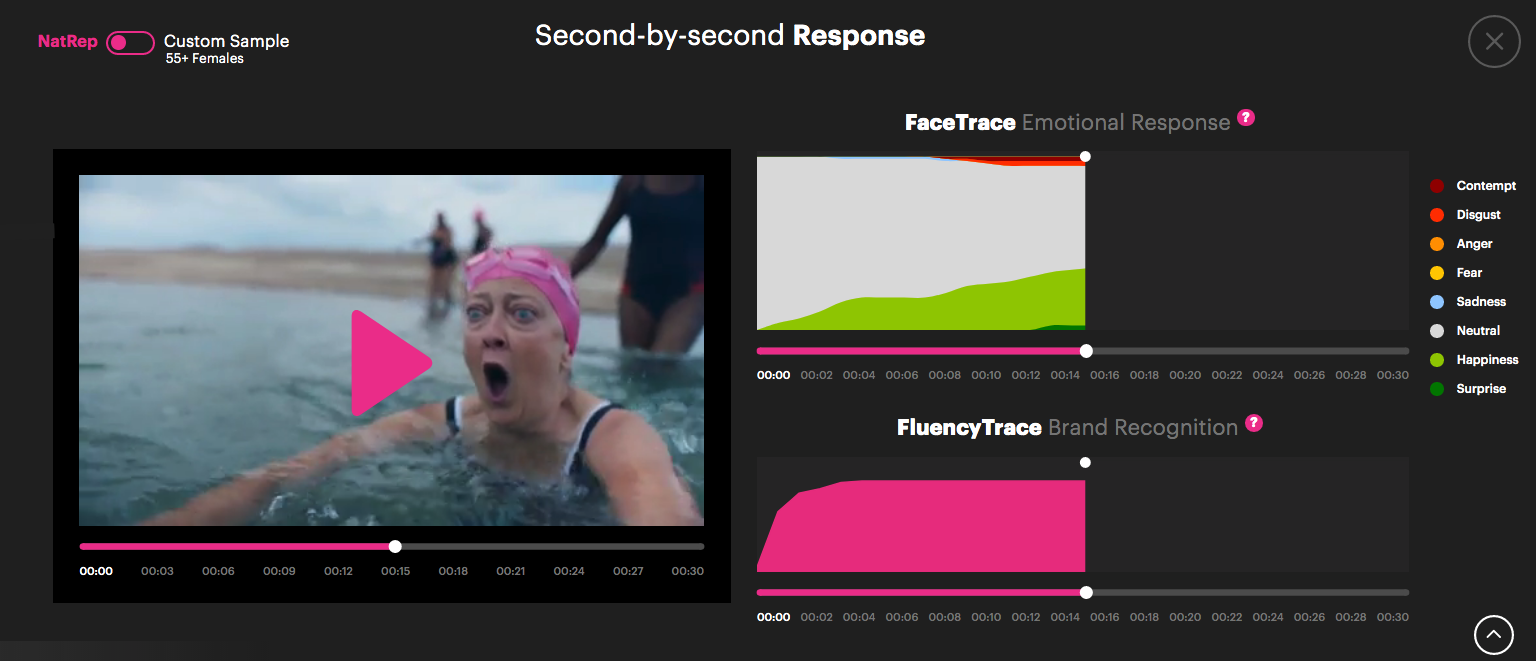
- Data revenue is supported by Test Your Idea and Test Your Brand, which perform the same online-panel function for product ideas and company brands:
- Test Your Brand and Test Your Idea were launched during November 2021 and May 2022 respectively.
- Data revenue is bolstered by Data-led consultancy revenue, which consists of follow-up improvements and guidance from SYS1’s marketing experts:
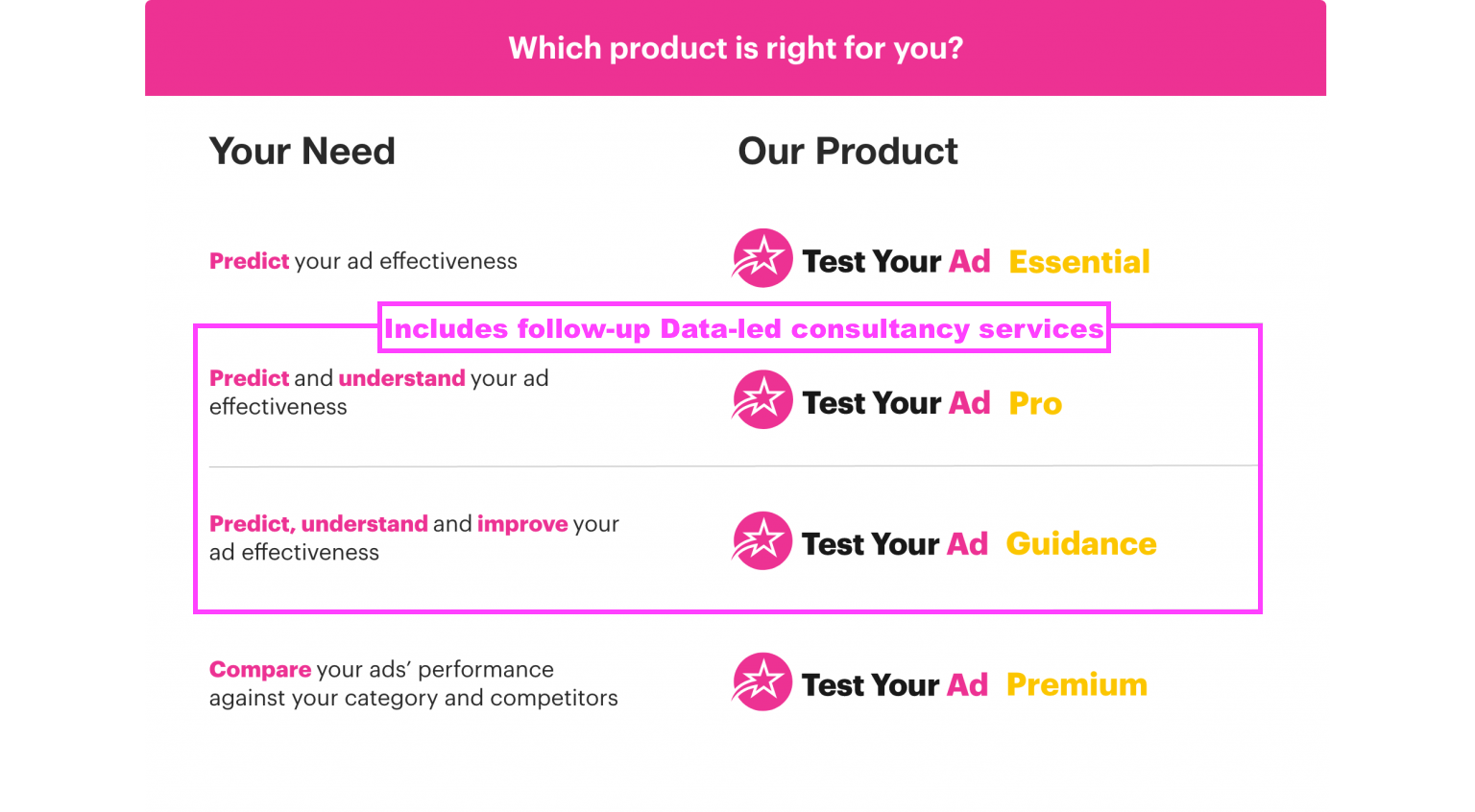
- This FY revealed H2 Data/Data-led revenue up 40% to £17.4m with:
- Q3 Data/Data-led revenue up 16% to £4.3m, and;
- Q4 Data/Data-led revenue up 81% to £5.5m:

- Management said during my Q&A that Q4 was “exceptional” and March was “the best month the company has ever done by a mile“.
- Management claimed during my Q&A that it did not know what happened during March to help generate the bumper Q4 revenue… but acknowledged the GM requisition “did not do any harm“.
- I interpret “did not do any harm” to mean management issued an ‘all hands on deck’ command during Q4 to generate extra sales to impress shareholders ahead of April’s GM.
- Management’s command worked and helped prevent an adverse GM vote, although July’s Q1 2024 update showed Data/Data-led revenue at £4.9m — down 11% on the preceding bumper Q4 2023:
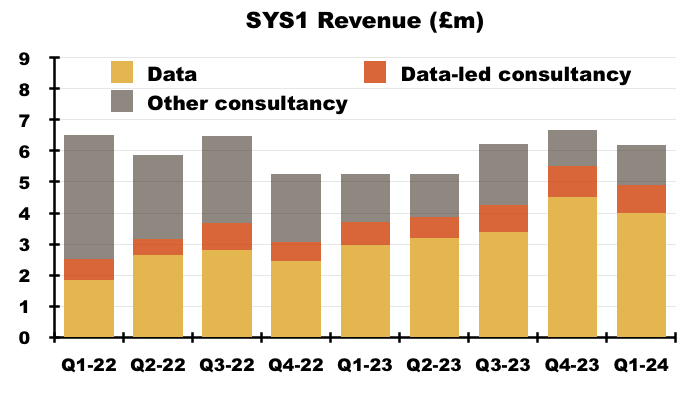
- The growth comparisons will naturally become harder during H2 2024 given the strong H2 2023 and bumper Q4.
- For example, 7% sequential quarterly growth from Q1 2024 would deliver H2 2024 Data/Data-led revenue of £11.6m — up 19% on H2 2023…
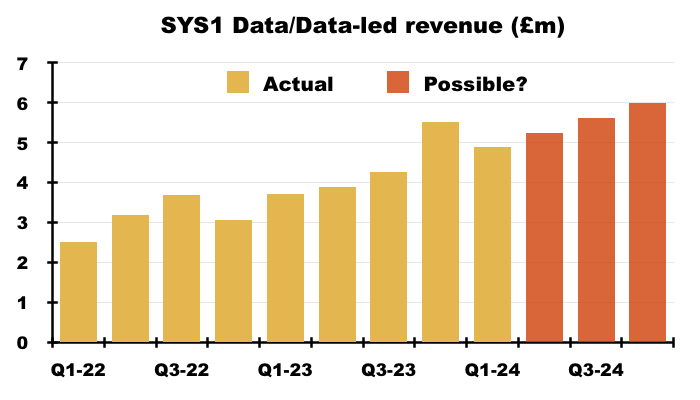
- …but also deliver Q4 2024 Data/Data-led revenue of £6.0m — up only 9% on Q4 2023.
- My 7% sequential quarterly growth projection gives FY 2024 Data/Data-led revenue of £21.7m — up 25% on this FY.
- SYS1’s response to the GM requisition suggested a minimum 25% Data/Data-led revenue growth rate to meet the aforementioned Rule of 40 ambition:
“We have stated our ambition to become a Rule of 40 company. To do this, we will need to deliver revenue growth of the ‘Predict Your’ and ‘Improve Your’ products, plus EBITDA margin, to total 40. While we are in growth mode, we expect the majority of this to come from revenue, so the Company will need to be growing revenue at a minimum of 25% over the coming years.”
- 25% annual Data/Data-led revenue growth would require an adjusted Ebitda margin of 15% to meet the Rule of 40.
- For perspective, SYS1 reported an 8% adjusted Ebitda margin for this FY.
- SYS1 has never disclosed the profit contributions from the Data/Data-led services versus the old bespoke Consultancy work.
- As such, that 8% adjusted Ebitda margin could have been supported entirely by old bespoke Consultancy work…
- …which would raise clear doubts about calculating the Rule of 40 by adding Data/Data-led revenue growth to the total adjusted Ebidta margin.
- SYS1’s Rule of 40 should be consistent, and add Data/Data-led revenue growth to the Data/Data-led adjusted Ebidta margin.
- The suspicion with the Rule of 40 using total adjusted Ebitda is the Rule would otherwise not be met because the Data/Data-led services lose money.
- SYS1 should make clear whether Ebidta from the old bespoke Consultancy work ensures the Rule of 40 is met, especially as Data/Data-led services now dominate the top line.
- Data/Data-led ‘platform’ revenue represented 74% of total revenue during this FY, with 82% represented during the bumper Q4.
- This FY implied the old bespoke Consultancy work should “level out” at £6m during FY 2024.
Test Your Ad versus Test Your Idea/Brand
- One complaint made by Mr Barden against SYS1 concerns its bias towards Test Your Ad versus Test Your Idea and Test Your Brand. Mr Barden told me earlier this year:
“Apart from mentioning they have Innovation and Brand services, you won’t see anything out there where they are doing anything to sell them. That’s why the sales of those areas have lagged. The advertising part has grown, but everything else has collapsed far faster because there is nobody focusing on them. The net result is flat-to-declining total revenue.“
- The FY 2023 presentation showed Test Your Brand growing to c£1m of Data/Data-led revenue during H2:
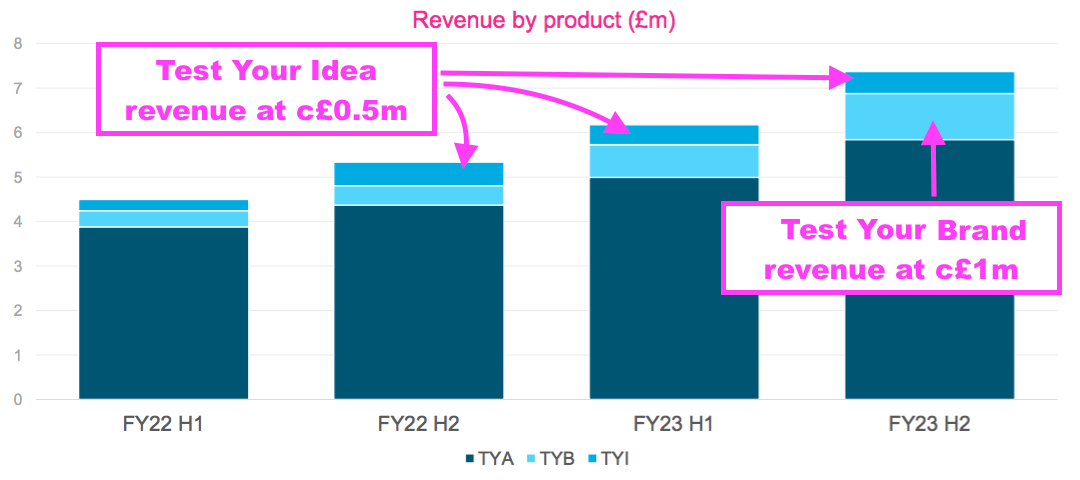
- Test Your Idea meanwhile remained at c£0.5m of Data/Data-led revenue.
- Note that Test Your Ad quickly managed to generate six-month Data revenue of £1.4m after its launch (during the pandemic!):
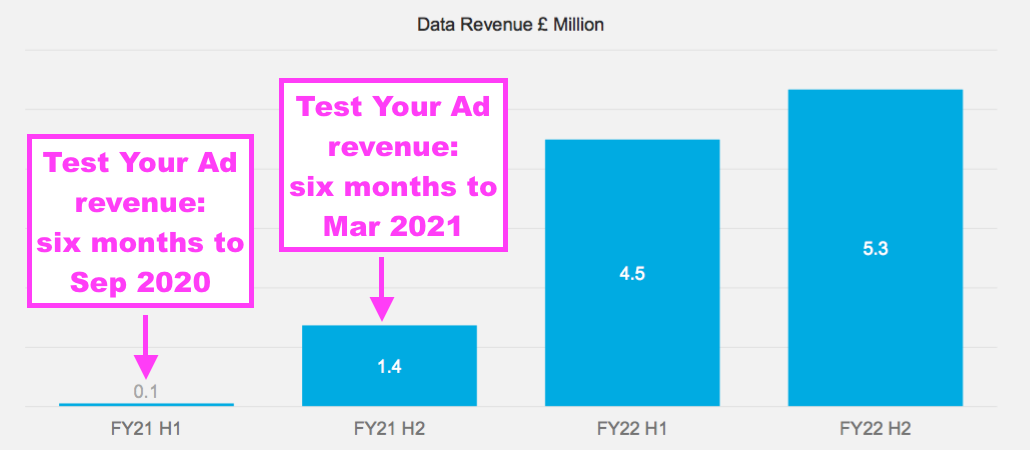
- Both Test Your Idea/Brand therefore appear to have experienced much slower starts than Test Your Ad.
- February’s Capital Markets Day re-emphasised both Test Your Idea/Brand have much larger market sizes than Test Your Ad:
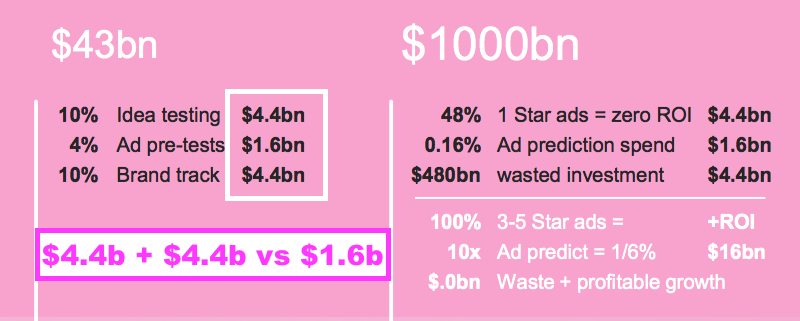
- SYS1 did not repeat that market-size slide for this FY.
- Innovation revenue (which includes Test Your Idea) dropped 34% during this FY, and declined every six months between H2 2020 and H1 2023:
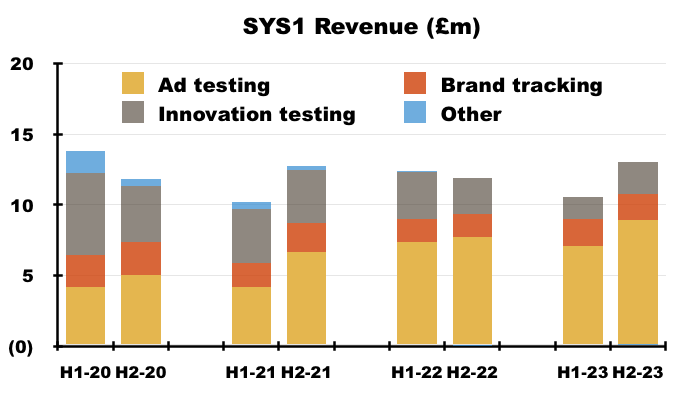
- Note that Innovation revenue topped £11m during FY 2019 to represent 42% of SYS1’s top line:
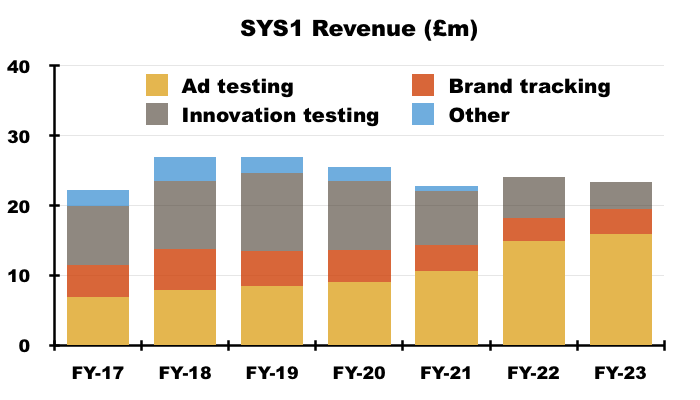
- Innovation revenue was less than £4m during this FY to represent 16% of the top line.
- I am sure the Innovation division remains dominated by old bespoke Consultancy revenue, and I get the distinct impression the division’s Test Your Idea plays second fiddle to Test Your Ad within SYS1 (see Orlando Wood and Uncensored CMO).
- Management’s FY webinar described Test Your Idea as an “untapped opportunity… to grow in the future” and confirmed “our ambition is for all three of these [divisions] to provide similar levels of revenue in the future“.
- Management made the following points about Test Your Idea/Brand lagging Test Your Ad during my Q&A:
- Test Your Ad enjoys a lot more industry recognition due in part to the “thought leadership” derived from SYS1’s Lemon and Look Out books;
- Test Your Idea/Brand were meanwhile “behind the curve” in terms of the equivalent promotion;
- Conversations are underway to decide how best to promote Test Your Idea;
- SYS1 first had to “double down” on Test Your Ad to “stabilise” the business;
- Because Test Your Ad’s win rate is “so good“, the sales team naturally focuses on that product;
- Due to the greater public visibility of advert spending versus idea testing, SYS1 is more likely to win a customer through Test Your Ad and then cross-sell Test Your Idea, rather than the other way around, and;
- Brand testing tends to involve multi-year contracts, which can be “difficult to win“, “quite commoditised” and “not as profitable” as testing adverts and ideas.
- Those management comments suggest SYS1 requires new books to help promote Test Your Idea, but sadly SYS1’s leading author is busy elsewhere…
Orlando Wood and Uncensored CMO
- Orlando Wood is SYS1’s chief innovation officer and wrote SYS1’s Lemon and Look Out books:

- The 2022 annual report described one book as a “seminal work” and claimed the other received “widespread critical acclaim“:
“We continue to be recognised for thought leadership in the industry. Following on from his earlier seminal work, Lemon, published jointly with the Institute of Practitioners in Advertising (IPA), our Chief Innovation Officer, Orlando Wood, published Look out, to widespread critical acclaim.“
- I have never been convinced about the effectiveness of Mr Wood’s own marketing.
- Three years ago Mr Wood wrote and presented the following SYS1 film:
• Where the Lemons Bloom” opens with the line “Kennst du das Land, wo die Zitronen blühn?” and then recounts the early life of German writer Johann Wolfgang von Goethe and his trip to Italy in 1786.
• Experience the full 21m22s recording, and you too may think you have inadvertently tuned into a BBC4 history documentary.
• Just how this somewhat indulgent and rather dull film that talks of “brain lateralisation” is meant to resonate with modern-day marketing folk is not clear to me.
- Look Out also provided a deep lesson on art history:
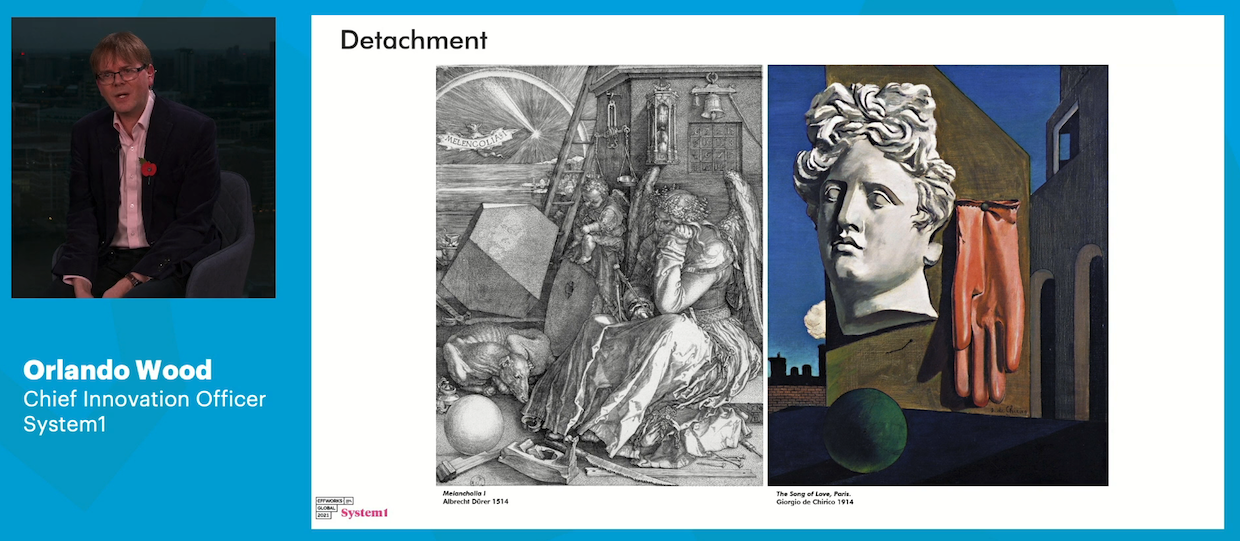
- Mr Wood is returning to film making. During this interview on SYS1’s Uncensored CMO podcast, Mr Wood revealed an upcoming marketing course that will include a series of films:
“[The course] is really made for marketing teams, who want to know how to get the most out of their creative and the space they buy.
It is going to look at many of the things in the books but other things, too. We talk about creating advertising in a digital age, we are going to look at the brain… we are going to talk about lessons that I think we have forgotten in some ways about how to stand out. There’s a lot in there that I think you might enjoy and find useful.
The course will be a practical guide and a series of films, each of which will have several important principles.“
- You can register your interest for Mr Wood’s course at orlandoonadvertising.com.
- Quite why SYS1’s chief innovation officer is spending time developing a marketing course when Test Your Idea/Brand are without their own books, “thought leadership” and wider promotion has not been made clear.
- Whatever the reason, SYS1 has reduced its sales opportunity significantly by overlooking Test Your Idea/Brand, which in turn has helped rivals win market share (see Zappi).
- This FY talked of SYS1 being “relentlessly focussed on execution against our strategy”, but Mr Wood’s new course suggests he has escaped/ignored/missed that board instruction.
- All the course work, film making, German literature and art studies do make me wonder whether Mr Wood:
- Has ambitions beyond SYS1 (in film, art, history and/or academia)?
- Sees advertising research more as an intellectual challenge than a business service?;
- Advocates SYS1’s platform strategy?
- Is actually concerned about SYS1’s poor financial history since 2017?, and;
- Is really that suitable to promote SYS1’s services?
- SYS1’s board — having survived the GM vote — really ought to be ordering senior managers to focus on Data/Data-led sales rather than approving distracting side projects with no obvious shareholder benefit.
- No wonder Mr Barden told me earlier this year that SYS1 had lost its “platform thinking“:
“System1 should be selling marketing predictions. What System1 should not be doing is selling advertising creativity. And this is the fundamental issue, the creativity side has taken over and pushed the platform thinking out.”
- I note the podcast with Mr Wood discussed “moto e azione” and 17th century Italian artists…
- …but did not mention anything about SYS1’s “unmatchable” predictiveness or “world-class” platform.
- I asked management during my Q&A whether SYS1’s podcast should contain adverts for the group’s services.
- After all, SYS1 did launch Test Your Ad Audio during this FY.
- Management responded:
“We explicitly decided we did not want to do a sponsored-by-System1 podcast. We are number one in the marketing [podcast] charts, so it is a winning model. We are very happy with the ROI. If you listen to the podcast, System1 is mentioned in a clever way. We think that is more powerful than an intrusive ad half-way through.“
- The irony of course is SYS1 helps its customers intrude radio/podcasts with audio adverts…
- …but believes adverts — even for its own services — on its own show would interfere with the content.
- Management disclosed during my Q&A the Uncensored CMO podcast is “part-funded” by SYS1. I presume the other part is funded by the podcast’s host, SYS1’s chief customer officer Jon Evans.
Partnerships
- The comparable FY 2022 revealed the growing influence of partnerships on SYS1’s revenue:
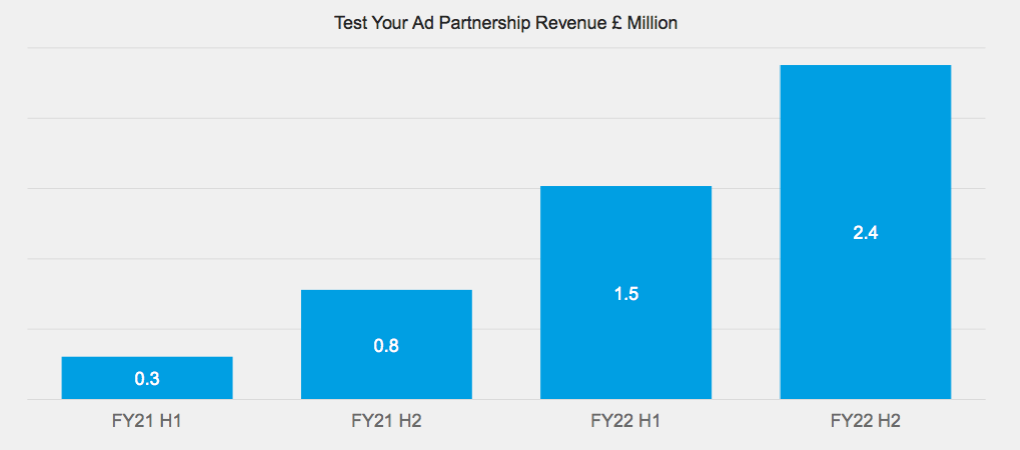
- An updated version of that chart was absent from the FY 2023 presentation…
- …which felt ominous because revenue from partnerships during FY 2022 was “the most significant source of new business”.
- The H1 strategic review gave prominence to forming new partnerships:
“In addition, significantly increase our focus on commercial partnerships with major ad platforms/media owners such as LinkedIn and ITV. These platforms provide the Company with access to multiple advertisers at significantly reduced customer acquisition costs.
Furthermore, we will target advertising & media agency groups, such as Omnicom/BBDO, and professional service firms who provide advertising effectiveness advice to multiple clients, with a view to including our ‘Test Your’ and ‘Improve Your’ products in their suite of service recommendations, again reducing customer acquisition costs.“
- Partnerships with high-profile media groups such as LinkedIn and ITV help verify SYS1’s claim of supplying “unmatchable predictiveness alongside market-beating speed and value”.
- This FY defined partnerships as “formal” and “informal“:
2. Partnerships provide direct or indirect access to a large customer base.
This access can be formal and direct, such as our partnership with LinkedIn, where we are part of the LinkedIn B2B Edge programme, helping LinkedIn grow its advertising revenues by increasing the effectiveness of the advertisers on their platform.
This can also be informal, such as our partnership with ITV, where we jointly host events to promote our thought leadership, directly to the ITV customer base.“
- Management disclosed during my Q&A:
- LinkedIn as a “formal” partner pays SYS1 to test and improve the adverts of some of its top advertisers.
- SYS1 then hopes to persuade those LinkedIn customers to use its services further.
- Partnership revenue declined during this FY because of lower LinkedIn spending, although management could not give a partnership revenue figure due to an “internal reorganisation“.
- ITV as an “informal” partner does not pay for its customers to use SYS1’s services. ITV instead commissions SYS1 research, participates in joint events and pays for its own ad-testing.
- SYS1 does not pay anybody to become a partner or introduce customers.
- This FY reiterated partnerships would help reduce customer acquisition costs:
“WORK WITH COMMERCIAL PLATFORM AND MEDIA PARTNERS TO REDUCE CUSTOMER ACQUISITION COSTS AND PROVIDE SCALE AND FAME
We have a clear business model to ensure that our partnerships with global media platforms, creative agencies, industry partners and professional service firms is successful.”
- The breakeven performance at best for this FY suggests customer acquisition costs have yet to reduce and partnerships are not currently yielding significant income.
- The lower rate of LinkedIn payments puts the spotlight on SYS1’s own sales team to drum up enough new business at an acceptable cost (see Sales and marketing).
Clients and customers
- SYS1’s disclosure of customer numbers remains frustratingly inconsistent.
- The comparable FY 2022 disclosed 209 new customers and a total of 465:
“Our Test Your Ad automation, increased industry profile, and Partnerships with ITV, LinkedIn, Globo, enabled us to win 209 new customers in the year, many of which are industry leaders like Lenovo and H&M. Our total customer base rose to 465, an increase of 17%.”
- The preceding H1 then disclosed 240 Data customers:
“We had 240 Data customers in H1, of which 85 were new.”
- And this FY disclosed 149 new platform clients.
“FY23 was a record year for new client acquisition, based on our platform automation and increased fame building, amplified through many global partnerships. We recruited 149 new platform clients in the financial year (previous year: 117).“
- Note the comparable FY 2022 referred originally to 209 new customers, but this FY has restated that 209 to 117 new platform clients.
- Management explained during my Q&A how ‘customers’ and ‘clients’ have different meanings:
- A multinational ‘client’ can provide SYS1 with multiple regional ‘customers’ (e.g. Coca-Cola could be the ‘client’, but ‘customers’ could be Coca-Cola (UK) and Coca-Cola (Brazil)). Contracts are signed with the legal ‘customer’ entity.
- Mix in SYS1’s references to either total, Data or platform for clients and/or customers, and shareholders can be forgiven for mis-interpreting SYS1’s progress.
- I have assumed this slide provides definitive customer numbers:
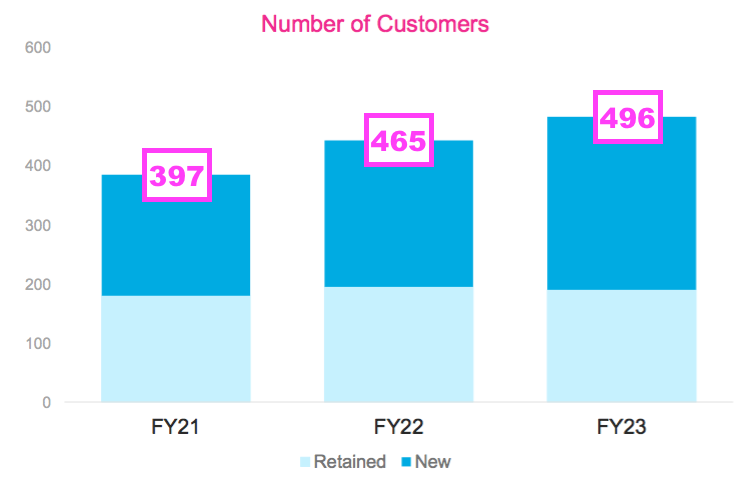
- That said, the 496 I have derived for this FY follows FY 2022’s 465 customers and then adds a net 31 new clients (not customers!):
“A year of focussed fame building, amplified by new partnerships resulted in strong growth in the number of new platform clients in FY23 (net increase of 31), and new revenue (net increase of £5m, of which £3m was from clients recruited in FY23). “
- Revenue per customer for FYs 2021, 2022 and 2023 was £58k, £52k and £47k respectively (possibly!).
- Declining revenue per total customer is not surprising given customers have shifted towards SYS1’s lower-cost automated Data services where ad-tests start at £2.5k:

- This FY indicated the top 10 customers on average generated revenue of £820k:
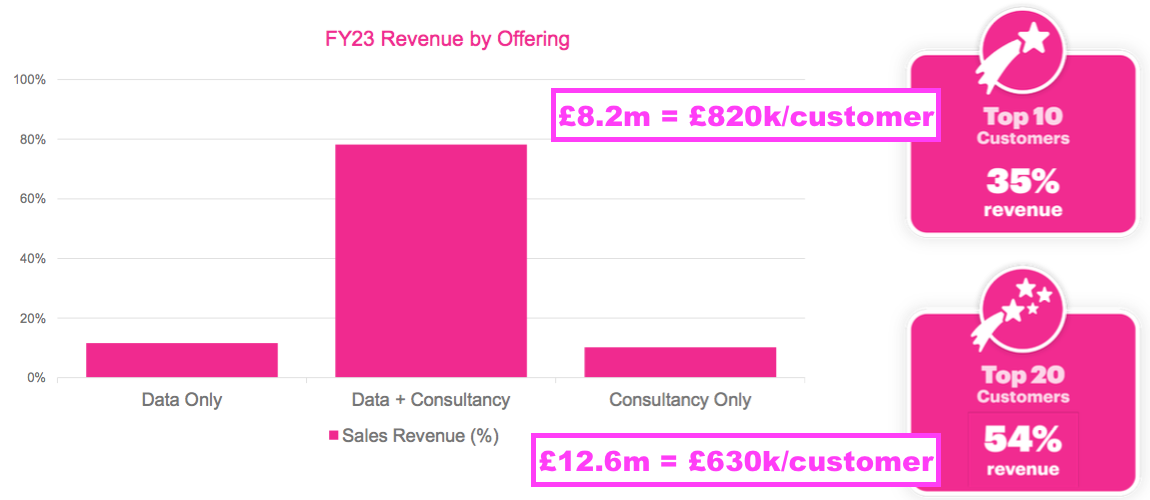
- Customers 11-20 on average generated revenue of £445k.
- Customers 21-496 on average generated revenue of £23k (possibly!).
- Management said during my Q&A that the customer base is skewed by a “long tail” of SMEs spending “something like £2k” a year, which “was not very attractive” for SYS1.
- Bear in mind old bespoke Consultancy income was £6.0m during this FY…
- …and if that £6.0m was attributable entirely to the top 20 customers, then those top 20 customers would have spent £6.6m on Data/Data-led services… or £330k each.
- Exactly how much SYS1’s larger customers are paying for what type of service remains irritatingly unclear.
- SYS1 must provide consistent customer numbers for shareholders to:
- Accurately assess the group’s platform economics, and;
- Determine whether the business is in fact supported by a handful of bespoke Consultancy customers paying several £000k each every year.
- OnTheMarket (OTMP) provides a useful comparison for investor ‘platform’ disclosure.
- Similar to SYS1, OTMP is a small AIM-traded company with a haphazard financial record and a fledgling platform trying to disrupt much larger incumbents.
- And yet OTMP spotlights its different ARPA (average revenue per property advertiser) measures clearly within its investor presentations:
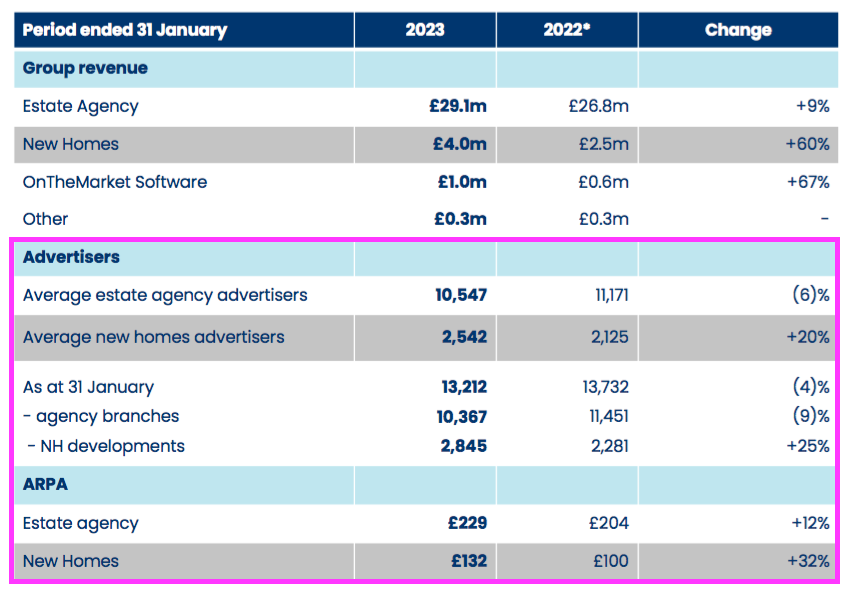
- Why can’t SYS1 also provide such clear stats about its average revenue per customer?
- I worry SYS1 does not present such vital platform measures because they:
- Would divulge unfavourable trends;
- Are difficult to calculate because the internal data is not clear, and/or;
- Are not uppermost in management’s thinking, which would underline why Mr Barden had “lost confidence with the board understanding the economics of a ‘platform’“.
- Management did however disclose during my Q&A the average customer lifetime value was £80k versus an acquisition cost per customer of less than £20k.
Sales and marketing
- SYS1 revealed £3m of the extra £5m Data/Data-led revenue for this FY was derived from new clients:
“A year of focussed fame building, amplified by new partnerships resulted in strong growth in the number of new platform clients in FY23 (net increase of 31), and new revenue (net increase of £5m, of which £3m was from clients recruited in FY23).“
- £3m from 31 new clients implies £97k each, and perhaps an annualised run-rate of £194k each.
- £194k per new client compares well to the aforementioned £47k customer average, and suggests SYS1 is indeed attracting larger customers…
- …although bear in mind the aforementioned SYS1 distinction between clients and customers!
- SYS1 employed 48 people within its sales and marketing department during this FY:

- This FY commendably disclosed a breakdown of staff costs:
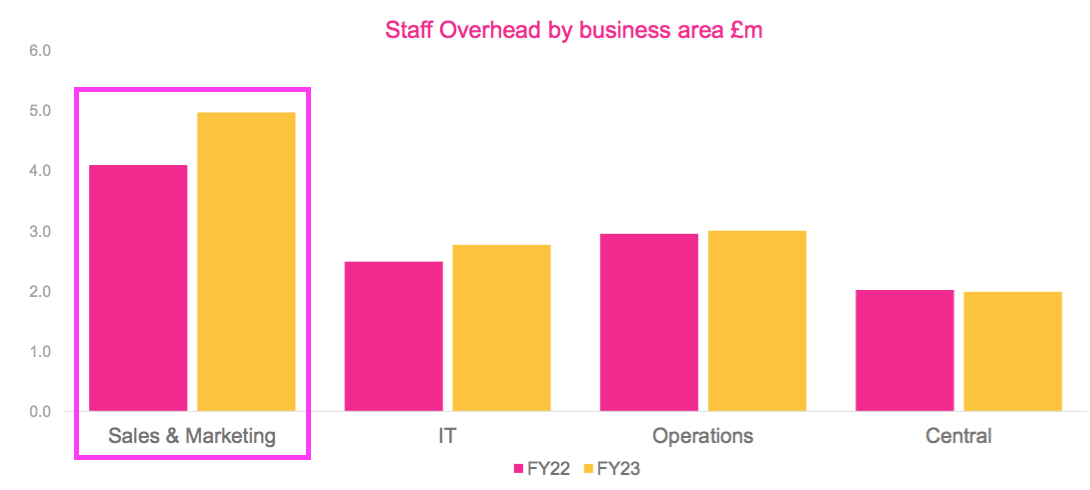
- Sales and marketing staff costs look to have increased by approximately £1m or 25%.
- The average cost per sales and marketing employee therefore appears to have gained approximately £10k to £104k during this FY.
- Management said during my Q&A that 20% of the sales team was dedicated to winning new business, with the other 80% focused on account management (i.e. helping larger customers with purchase decisions).
- Management’s FY webinar signalled sales and marketing costs would not grow as fast as revenue during FY 2024:
“As we grow revenue, admin, IT and operations will require few if any additional heads, and the sales and marketing overhead will grow but at a much slower rate than revenue, so that just emphasises this is a highly operationally geared business that is scalable and so the economics as we go forward and grow should be attractive“
“The big growth in sales and marking was absolutely deliberate and we will likely see some growth in the current year over last year, so that trend will continue probably at a slightly slower rate”
- I am hopeful a mix of greater revenue and a lid kept on costs can soon lead to favourable operational gearing emerging within the accounts (see Valuation).
Zappi
“I point to Zappi.io as a benchmark. Arguably Zappi has a worse product but such clear marketing and sales focus that it has overtaken System1 on both revenue and reputation. In the US ‘MarTech’ press, Zappi is the assumed leader in the marketing-predictions space. System1 needs to acknowledge this issue and address it urgently and head-on. I have made these points for three years now, without being heeded. Hence I unfortunately do not hold out much hope for any change soon.“
- Zappi raised $170m during December through Sumero Equity. Zappi has bold ambitions for its marketing-data platform:
“Zappi has a bold vision for the future: we want to digitise consumer insights for every enterprise,” said Steve Phillips, CEO and co-founder of Zappi.
“Today, only 3% of the market-research industry is digitised. The other 97% is controlled by service-based incumbents that are slow, expensive, analog, and don’t fit the needs of creators. We’re driving innovation in the century-old industry with a platform that acts as a single source of truth for the modern enterprise, where creators have the right insights at their fingertips to inform every decision. Sumeru’s experience in high-growth, innovative SaaS businesses and commitment to people and growth culture made them the perfect partner to help us achieve this ambitious vision.”
- The video below shows how Zappi’s system works:
- This TechCrunch article described Zappi focusing on what SYS1 defines as Innovation testing:
“The core of [Zappi’s] product is that it helps… customers run surveys on ideas as they weigh up what kinds of products to develop as well as early insights into how best to market them. Zappi is mostly used at the pre-product stage…”
- Happy Zappi clients include PepsiCo, Vodafone, McDonald’s and Reckitt Benckiser.
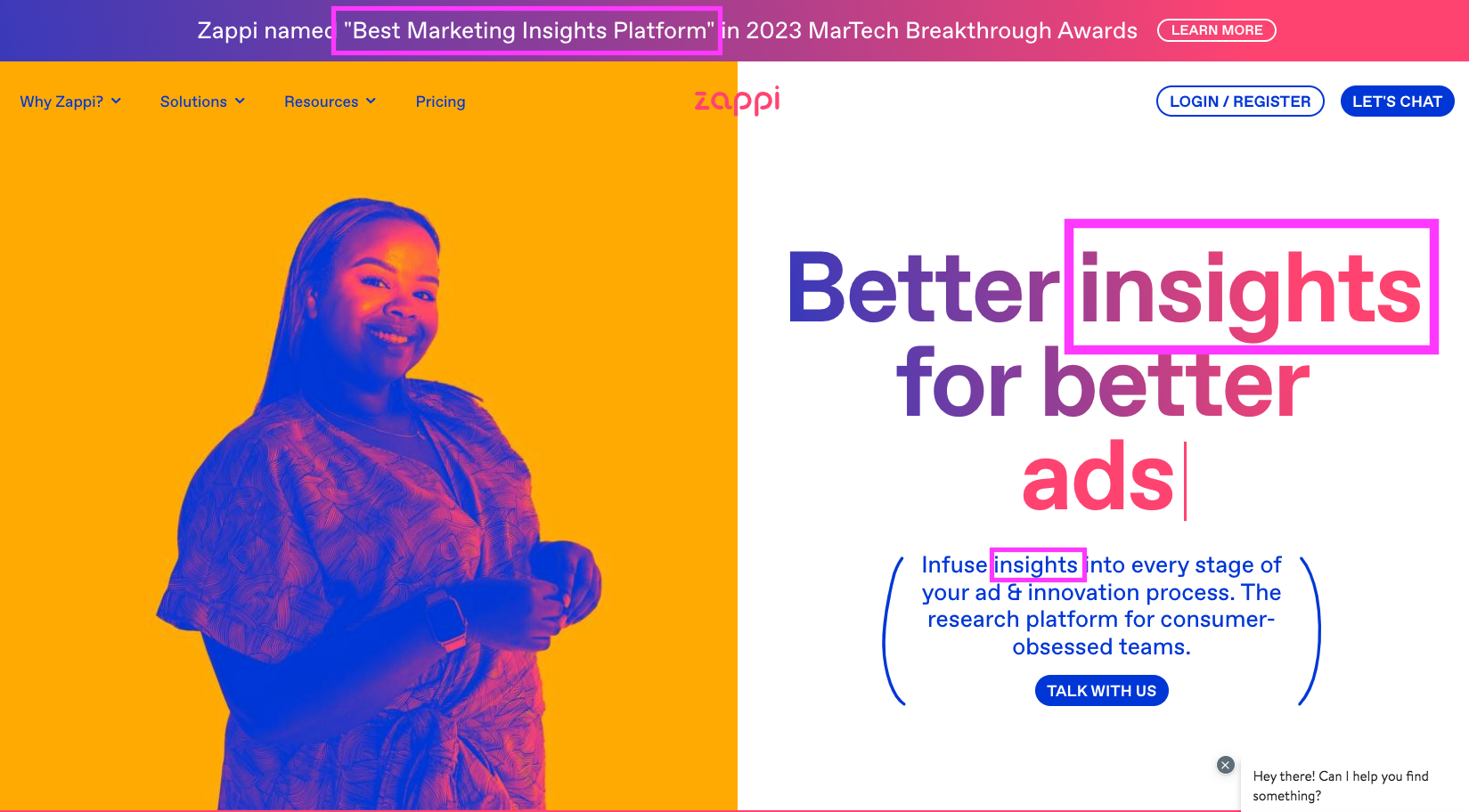
- In contrast, SYS1 dedicates its sales efforts towards chief marketing officers (CMOs):
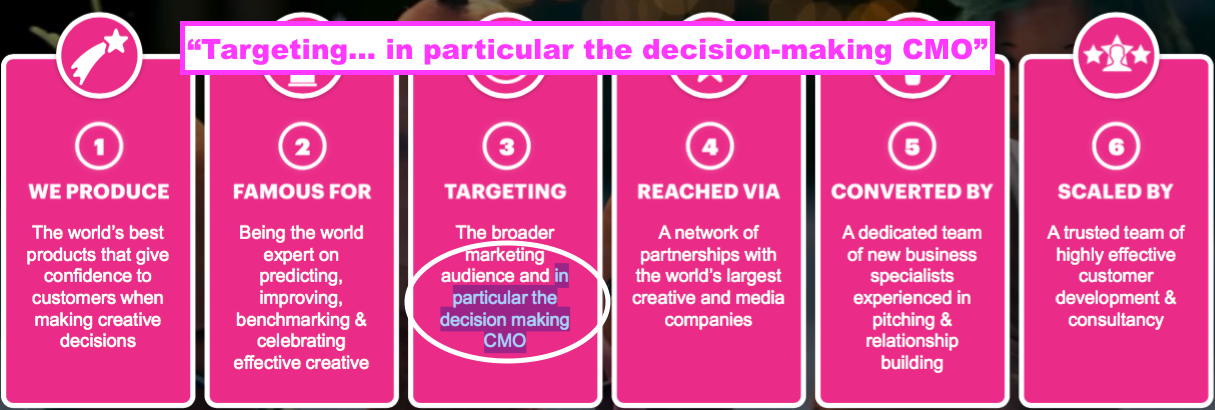
- Management said during my Q&A that CMOs are targeted because they “control the budgets“.
- Persuading CMOs can be a long process. The 2023 annual report highlights how Tesco‘s CMO was won over after SYS1:
- Published a report with ITV featuring the supermarket;
- Hosted a panel event with the supermarket;
- Spotlighted the supermarket in an email, and;
- Worked with the supermarket’s ad agency:

- My notes from the 2019 AGM recall SYS1 struggling to convert marketing ‘insights’ teams:
• [Mr Kearon] said chief marketing officers [CMOs] generally accept the benefits of the System1-style of advertising and are open to experiment. Trouble is, their Insights teams are risk-averse and wish to keep using existing suppliers/methods/data rather than throw away years of work and start again using other supplier/methods/data — even though SYS1’s services are simpler.
• [Mr Kearon] claimed Insights teams typically argue for no change (i.e. an easier life) — which is good news for incumbent ad-services suppliers such as Kantar. SYS1’s chairman mentioned many large organisations suffer from “large inertia” when it comes to marketing change.
• Upshot is SYS1 has to make a “compelling case” to CMOs to get them to change the habits of their Insights teams. SYS1 has previously targeted (change-resistant) Insights teams, but is now talking more directly to CMOs.
- Zappi does not seem to have sales difficulties with marketing-insight managers.
- Zappi was established in 2012 and Companies House shows revenue surging from £6m to £35m between 2015 and 2021:
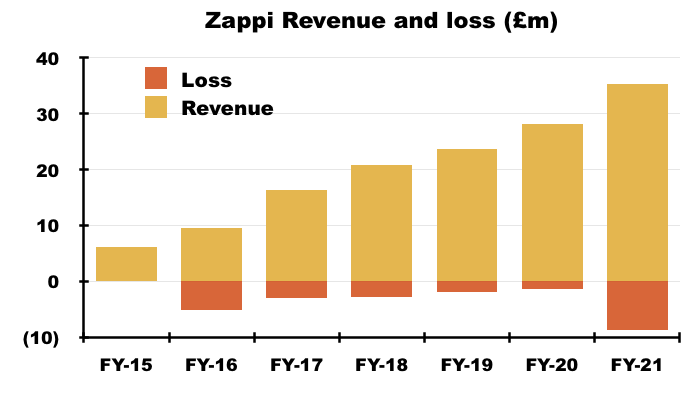
- Between 2015 and 2021, Zappi’s growth was supported by equity funding of £15m and net new debt of £8m.
- Zappi’s growth may also explain why SYS1’s own Innovation revenue has declined from more than £11m to less than £4m since FY 2019 (see Test Your Ad versus Test Your Idea/Brand).
- Zappi’s employees (at least during 2021) appeared to be less productive and more expensive than SYS1’s employees:
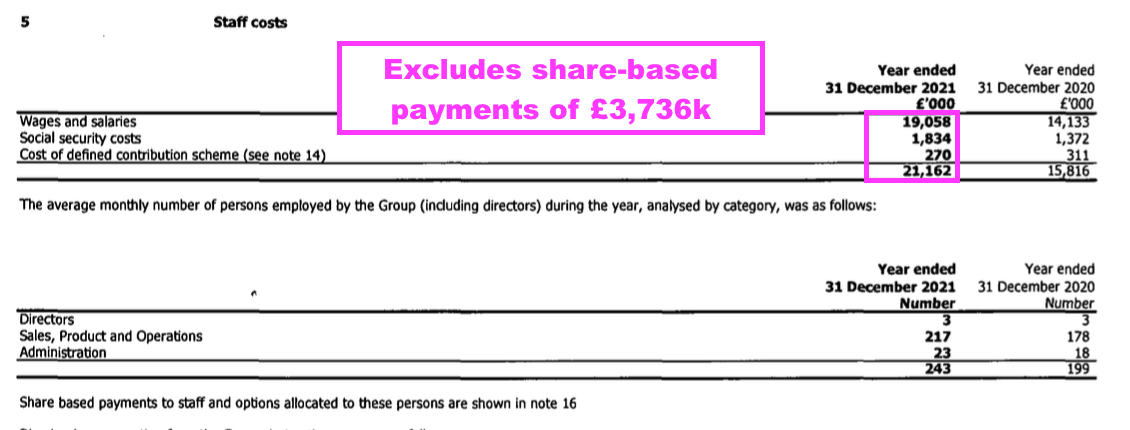
- Revenue per Zappi employee during 2021 was £145k versus £155k for SYS1 during this FY.
- The cost per Zappi employee during 2021 (including share-based payments) was £102k versus £86k for SYS1 during this FY.
- Zappi’s gross margin has meanwhile bobbed between 66% and 78% since 2015, while SYS1’s gross margin has consistently topped 80%.
- Despite Zappi’s inferior economics (at least up to 2021), it is Zappi — not SYS1 — that has attracted the $170m investment.
- No doubt that $170m was attracted by Zappi’s much faster sales growth…
- …which may one day translate into very favourable economics should Zappi’s platform emerge as the Rightmove/Autotrader equivalent within the marketing-data sector.
- Zappi’s private-equity funding of $170m is equivalent to more than £10 per SYS1 share.
Financials
- SYS1 helpfully published additional cash flow information for this FY:
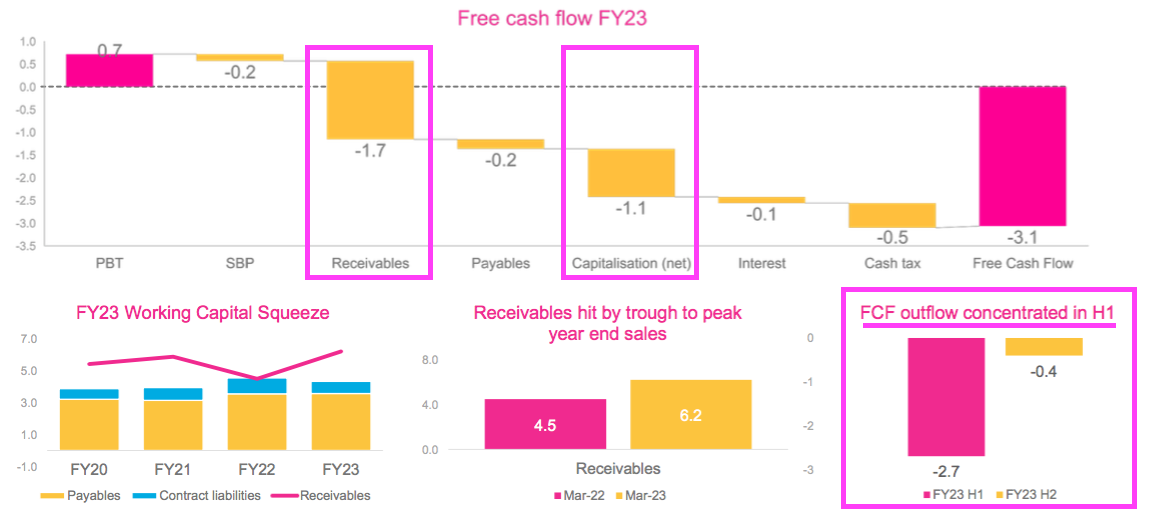
- The stronger H2 ensured the H2 free cash outflow at £0.4m was much lower than the very unwelcome £2.7m outflow reported for H1.
- SYS1 highlighted the extra £1.7m absorbed by greater receivables, although FY trade receivables at £5.7m were equivalent to 24% of revenue and not out of keeping with previous years:
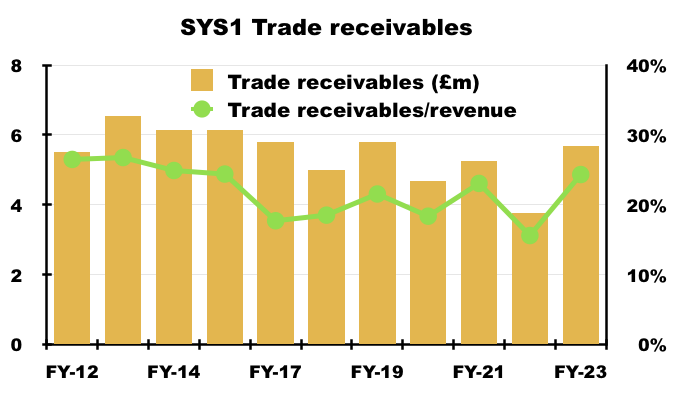
- Software development of £1.2m bypassed the income statement:
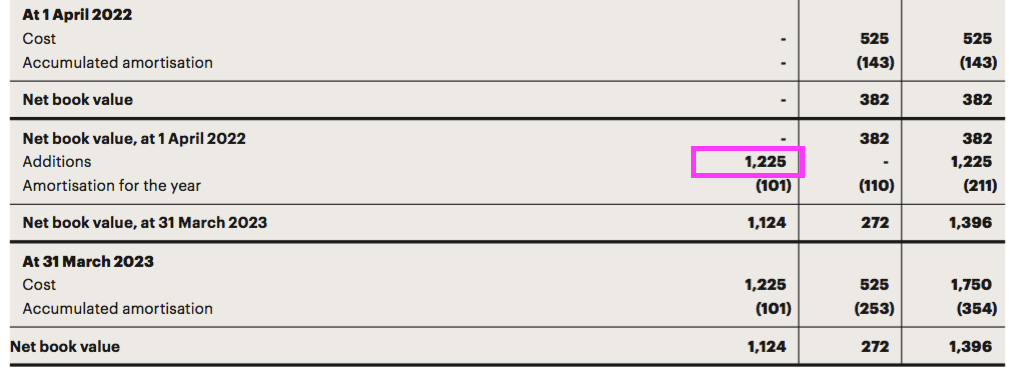
- The footnotes suggested capitalised software expenditure may be lower during FY 2024:
“Development costs relate to costs capitalised for the development of the “Test Your” platform (carrying value £865k), which completed during the year ended 31 March 2023, and the Supply Chain Automation platform (carrying value £259k), which is due for completion in the year ended 31 March 2024.”
- SYS1’s capitalised software costs are amortised over three years, with amortisation of £101k expensed for this FY.
- Net cash declined by £3.0m to £5.7m during this FY, with £0.8m of that reduction occurring during the stronger H2.
- Net cash of £5.7m is equivalent to approximately 45p per share and roughly 20% of the £27m market cap.
- The lack of FY interest from that £5m-plus cash position was very noticeable now that the base rate exceeds 5%:

- For FY 2024, SYS1 could easily earn income of perhaps £50k-plus from placing some of that £5m within an interest-bearing account.
- SYS1 cleared its £2.5m bank borrowing during H2 to leave the balance sheet free of conventional debt.
- Management’s FY webinar helpfully revealed FY 2024 was likely to be “cash [flow] neutral“:
“Q1 revenue was good and at a level you would expect us to be profitable and we are seeing good or encouraging cash flow trends in the current year. For the current year, you should expect us to be profitable and broadly cash [flow] neutral and by cash neutral I mean plus or minus £0.5m.”
- Complicating SYS1’s accounts are regular adjusting items, the ‘exceptional’ nature of some are debatable:

- ‘Compensation for loss of office’ for example has been reported every year since FY 2012 (total £1.8m).
- At least management said during my Q&A that ‘bonus and commissions expense’ is likely to be restated as a standard cost for FY 2024.
- The aggregate difference between adjusted pre-tax profit and statutory pre-tax profit is a significant £4.2m between FYs 2020 and 2023:

- Perhaps the most promising profit measure during this FY was gross margin, which reached a record 86% during H2:
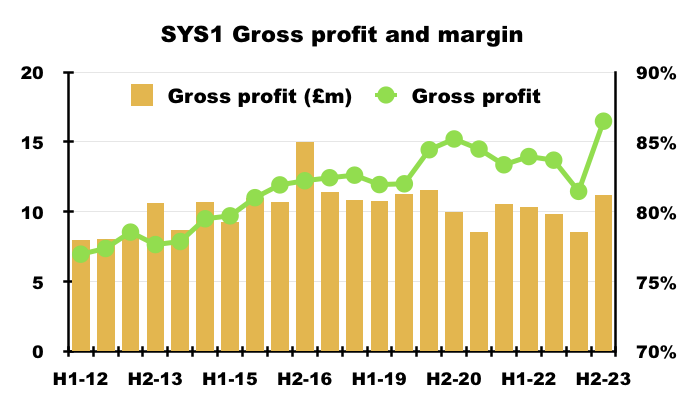
- An 86% gross margin implies SYS1 can buy online-panel responses for £14 and repackage that data for sale at £100.
- Revenue per employee at the aforementioned £155k was SYS1’s weakest since FY 2012 (£141k)…
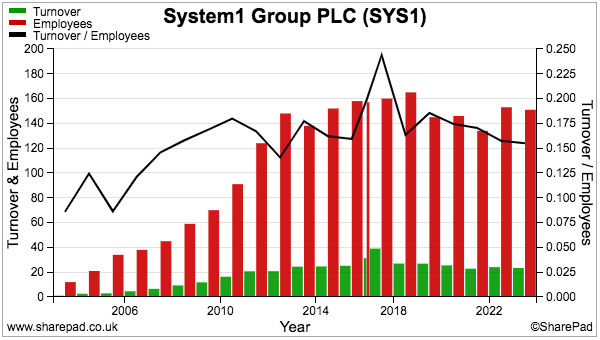
- …although the poor £138k for H1 improved to £171k for H2.
- Wishful thinking perhaps, but could that improvement show SYS1 evolving into a ‘scalable’ platform business?
Valuation
- SYS1’s breakeven performance, bevy of adjustments and negative cash flow does not make assessing the £27m market cap straightforward.
- But referring again to SYS1’s minimum 25% sales growth ambition…
“We have stated our ambition to become a Rule of 40 company. To do this, we will need to deliver revenue growth of the ‘Predict Your’ and ‘Improve Your’ products, plus EBITDA margin, to total 40. While we are in growth mode, we expect the majority of this to come from revenue, so the Company will need to be growing revenue at a minimum of 25% over the coming years.”
- ...let’s (confidently) assume Data/Data-led revenue advances 25% to £21.7m during FY 2024.
- Let’s also assume old bespoke Consultancy income stays at £6m and (confidently) assume the group gross margin is maintained at the record 86% witnessed during H2.
- Adjusted operating costs were £10m during H2, which annualised gives £20m. Let’s add on a further £1m to reflect extra sales people and the reclassification of bonuses as a standard cost.
- All those assumptions turn into a £2.8m operating profit ((£27.7m*0.86) less £21m)…
- …which alongside the net cash of £5.7m would not make the £27m market cap vastly expensive.
- Note that my calculations are rather optimistic versus the forecasts shown on SharePad:
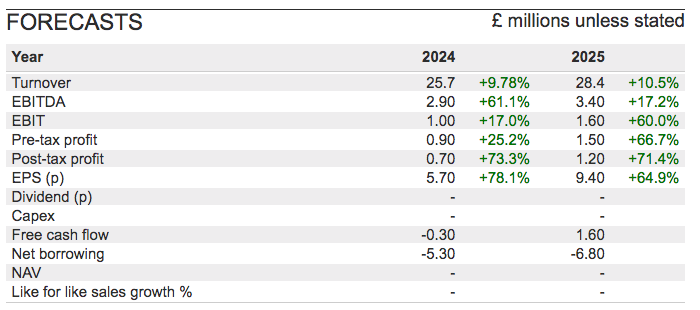
- Mind you, my sums do get me close to an Ebidta margin of 15%, which is required to meet SYS1’s Rule of 40 with Data/Data-led revenue growth of 25%.
- Furthermore, a £2.8m operating profit may produce management’s anticipated “broadly cash [flow] neutral” position for FY 2024 if:
- Extra receivables absorb another £1m;
- Capitalised IT absorbs another £1m, and;
- Lease-finance costs and yet more adjusting items absorb a good chunk as well.
- I am not sure whether the forecasts shown on SharePad get SYS1 to that Rule of 40.
- Of course, SYS1 needs to deliver 25% Data/Data-led revenue growth for my guesswork to become anywhere close to reality.
- But I do worry such 25% growth will not be achieved because:
- The stronger H2/bumper Q4 was a one-off spurred only by the GM;
- Test Your Idea/Brand will take a long time to flourish (if they ever do), and;
- The chief innovation officer (and others?) are not “relentlessly focussed” on platform revenue…
- …which in turn could leave worthwhile earnings frustratingly elusive despite SYS1’s “unmatchable predictiveness” and “world-class” IT.
- At least smaller shareholders have larger investors to help keep the board in check and ensure SYS1’s “unique IP” is maximised.
What next for larger shareholders?
- Mr Barden and Mr Geddes seem unlikely to call another GM, given Mr Barden made clear the GM was a “now-or-never decision“:
“This vote really is a now-or-never decision. Right now System1 can still compete with Zappi and become the dominant platform in the industry, but that opportunity is getting smaller and smaller and time is running out very quickly.
…
There’s no point shareholders approaching me again a year from now and then asking for these changes, because the opportunity for System1 to become the number one will almost certainly have gone for good.”
- If the GM proposals failed to gain enough support, Mr Barden said he would “hold management to account” while awaiting an exit at 440p:
“If at the GM the board and its supporting shareholders carry the vote against our resolutions and continue to support current management, then I will likely exit at £4.40, the share price at the time I stepped back, such is my lack of confidence in the current board to obtain £8/£10 per share.
…
If I do not become chairman, I’m therefore inclined to wait for the £4.40, and hold management to account accordingly. The ‘global #1 platform’ shareholders will increase board pressure until either the share price rises or ever-growing shareholder frustration will lead to patience eventually running out and board changes.”
- Further activist activity could be led by SYS1’s German shareholders, who control 16% of the group (although I understand may in fact speak for 23% through various other holdings):

- The German investors called for last year’s strategic review and installed a non-exec to keep tabs on board proceedings. They also (as I understand) voted for the proposed board changes at the GM.
- The German shareholders could requisition their own GM to propose their own board changes, but I see that as unlikely given:
- They would need to find credible management willing to run SYS1, and;
- The adverse outcome of the earlier GM.
- SYS1’s German shareholders may in fact harbour greater ambitions elsewhere. They — alongside other German investors — control Grafenia (GRA):
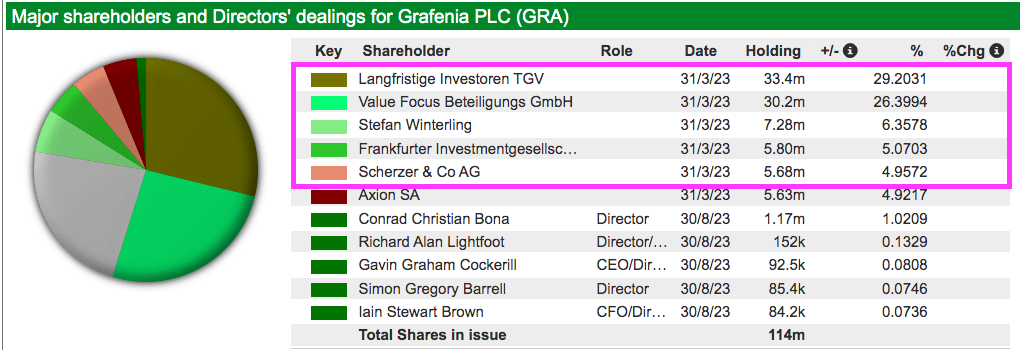
- SYS1’s German shareholders have restructured GRA into a “serial acquirer of vertical market software businesses“, and this month raised £23m to help fund new acquisitions.
- SYS1’s German shareholders — and other German investors — provided at least £13m of that £23m. For perspective, their collective SYS1 investment is valued at no more than £6m.
- Mr Barden told me earlier this year he planned to refocus SYS1 before selling the group to a trade buyer for at least £8 a share:
“It is Focus, Prove and Sell. System1’s products can be global leaders, but only if sold through an existing global salesforce with existing global sales relationships. It is hubris to think System1 can build this capability organically itself. But global buyers will want proof before they pay a premium. Over the next few years we prove the System1 business really works, and then sell it. Shareholders will get a percentage share of the synergies that the new owners get. The crux is there is a big chunk of synergy there that shareholders would receive. Shareholders would also be able to realise this gain without selling at a discount.“
…
“I think this business is worth £100m at least, £8 a share, if not £125m, £10 a share.”
- Trade buyers are now able to step in and refocus SYS1 themselves at a valuation much less than £8 a share.
- Possible buyers may include smaller rivals such as Zappi/Sumero Equity, which could combine Zappi and SYS1 to form a very attractive marketing-technology platform with the chance of truly disrupting the traditional market-research industry.
- Ipsos for example offers a range of SYS1-type digital services using “behavioural science principles” to evaluate and optimise product ideas and advertising campaigns.
- Ipsos is targeting “fast development” of its Ipsos.digital division…
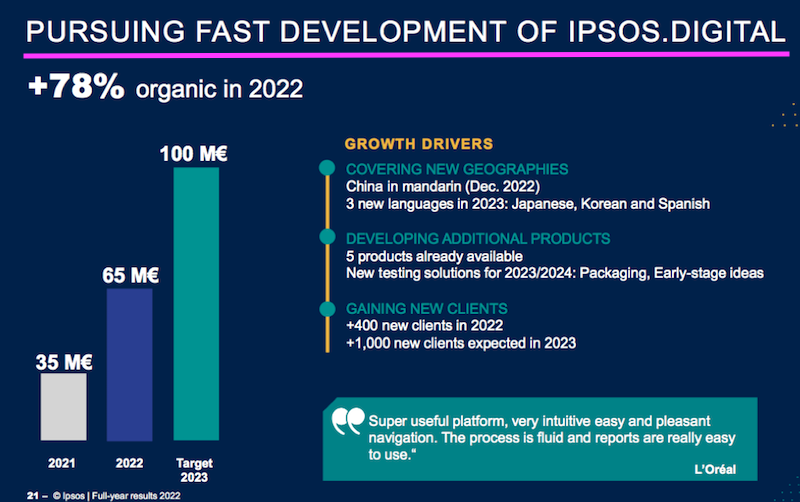
- … and the group is set to spend between €100m and €200m a year on acquisitions:

- Kantar Marketplace meanwhile “brings together the best of technology and human expertise in a powerful market-research platform, so you get decision-quality insights in as little as a few hours.”
- Kantar spent almost $1.5b on acquisitions during 2021 and 2022. Purchases included marketing-data/SYS1-like operators such as:
- Advertising ROI optimiser Blackwood Seven;
- Marketing effectiveness tracker MeMo2, and;
- Consumer survey platform Qmee.
- I speculate SYS1’s divided shareholder base has now left the door wide open to corporate activity.
- I dare say the 35% of shareholders who voted against the board at the GM will be very tempted by a suitable premium to the 215p share price…
- …and I suspect some of Mr Kearon’s 36% support will be tempted as well.
- The 215p shares are, after all, at a level first witnessed more than 10 years ago:
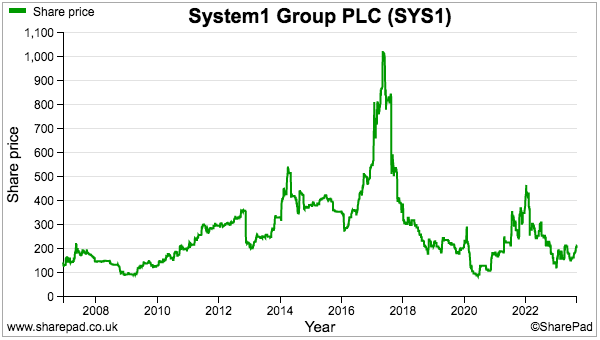
- Mr Barden at least is now looking to exit at 440p, which seems as informed a benchmark as any for layman shareholders to judge SYS1’s value to a potential suitor.
- 440p gives a £55m market cap and may well be achieved if a trade buyer can foresee significant cost savings and/or healthy extra sales.
- SYS1’s slides helpfully disclosed central staff costs of £2m…
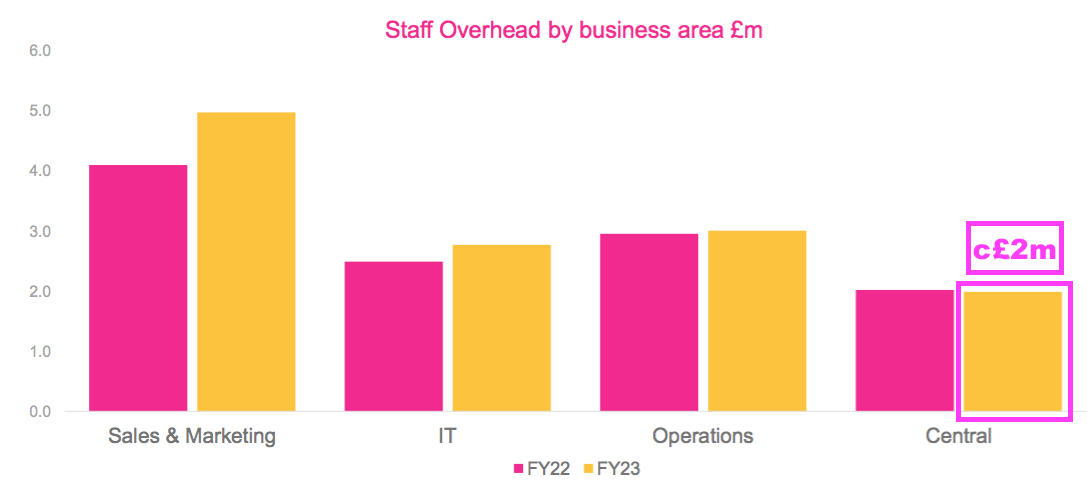
- …and corporate expenses of approximately £1m…

- …which I suspect could be eliminated quickly in any combination.
- Furthermore, SYS1’s “unmatchable” predictions and “world class” IT ought to be an easy cross-sell to the wider clientele of Ipsos, Kantar or some other global researcher…
- …and therefore that £5m spent on SYS1’s sales and marketing employees could be reduced significantly, too.
- The likes of Ipsos and Kantar would also seem more likely to find further large clients.
- For example, SYS1’s largest ten clients each pay an average £820k a year, and another five of those at an 86% gross margin would lead to an additional £3.5m gross profit that — if ‘platform’ costs remain fixed — would flow to the bottom line.
- I speculate a suitable trade buyer could in time enjoy sales/cost benefits beyond £7m to make Mr Barden’s 440p/£55m very appealing.
- Director comments during the GM claimed the board was “not frightened of a capital event”, which provides hope founder John Kearon is open to good offers for his 22%.
- I supported the proposed GM board changes, and would very much welcome any further action from Mr Barden, the German shareholders and/or interested trade buyers.
Maynard Paton

Thanks for the very thorough review Maynard, very informative. By my reckoning John Kearon is at least 58 (based on him leaving University at 21, Thank you LinkedIn), so whilst not exactly ancient he’s old enough to want to potentially leave the corporate world (and perhaps do more of the dancing that he seems to be more passionate about than anything else!) and maybe that explains why the System1 management seem content to plod along? So maybe a buy out isn’t so far fetched, though it might just be wishful thinking from a frustrated holder.
Thanks Paul. Companies House says Mr Kearon is indeed 58 (this month). The general meeting suggested Mr Kearon was not keen on leaving just yet, although I do think he is better suited in his present sales role than his previous CEO role that required more involvement with practical business matters. Stefan Barden reckoned he could re-focus the business and then sell it, although as you say a buyout now may well be wishful thinking!
Maynard
Pretty decent results announced this morning.
Hitting Canacord’s FY Pbt forecasts in H1 suggests upgrades should be on their way (perhaps accompanying the Interims when some Q3 visibility is apparent). Cash inflow also welcome.
Especially good to see the link between increased revenue and improved pbt which does reinforce the view the business could be nicely profitable if the current revenue trends continue.
Hi Maynard
IMHO – Overall a pretty decent set of interim results today. But the management outlook is still uncertain. I guess that new advertising campaigns are naturally ‘lumpy’ and so their income isn’t much like a real SAAS model. i.e. their ‘platform’ might be excellent, but it does not guarantee any particular level of income.
Given the downside risks, I wouldn’t be surprised if the SP did drop back again but I do feel that the team and especially John Kearon deserve some credit for the success so far.
As always, thank you for all your hard work.
Charles
NB – I am very sad that Charlie Munger died. He was a wonderful man.
Hi Maynard
I thought that the SYS1 H1 InvestorMeet presentation was excellent. It might even be the cause of the subsequent price rise. As you might have seen, I put my question about lumpiness and the reply implied that it was not a big problem and that it would also get less of a problem as they grew. Do you have any thoughts on their answer?
I definitely wish you well with this investment as it is your biggest investment. For me it is just a 1% long term holding but at this rate it could grow quite fast!!! (although I expect that it will be very lumpy).
Thanks as always – especially for all the massive work that you continue to do on analysing this company.
Charles
Hi Charles,
Management referred to the non-platform bespoke lumpiness, and such lumpiness should indeed have less impact if the platform side grows significantly. Mind you, platform revenue can fluctuate between quarters (e.g. Q4 2022->Q1 2023) but management noted platform income from the top 20 customers should be less volatile. I think quarter-to-quarter fluctuations will continue to occur, though, which could cause some anxiety for anyone who does not believe the long-term transition story.
Maynard
Hi Maynard –
Previously Mr Barden seemed to think that a buyout price of £4.40 was a good deal for shareholders. But he also said: “I think this business is worth £100m at least, £8 a share, if not £125m, £10 a share.”
Kearon himself suggested £1bn a while back (i.e. £80 a share)
I know that you normally buy and hold, but this is becoming a huge holding for you and I imagine that you are thinking about the long term value. I’m looking forward to your next update!
Well done.
Charles
PS – I was buying a few more at c£4.20 in February.
Hi Charles
Yes, Mr Barden said he was happy to sell a year ago at 440p when the shares were c200p. He also talked of selling SYS1 to a trade buyer after 3 years at £8-10 a share had he become executive chairman at last year’s EGM.
The £1b value was touted jointly by Mr Kearon, Mr Barden and the FD a few years ago, and was watered down when Mr Barden left the company. The £1b value was cited with SYS1 becoming part of a larger marketing business -> “You can get System1 to a billion if it is owned by a major multinational.” (More here)
Mr Barden said during his EGM statement:
“6) Valuation: As a result, and you might want to pass this to Chris, if successful, how much could System1 be worth in say 2 to 3 years time?
a) If you can’t give a valuation what would the shape of the P&L be? For example, your 25% CAGR sales growth aspiration is a doubling in sales every 3 years. What is the associated cost structure?”
The Capital Markets Day in February provided an illustration of what could happen to profit (or at least Ebitda) if sales did double. If that illustration proves reasonably accurate, then maybe the shares still offer good upside. Steadily clearing my backlog of updates from other portfolio companies (ASY+MTVW) then I will be onto SYS1.
Maynard
System1 (SYS1)
Publication of 2023 annual report
Here are the points of interest beyond those noted in the blog post above:
——————————————————————————————————————
1) GROUP OVERVIEW
Some changes here for 2023:
a) Who we are
The 2022 report contained encouraging text such as “best in the world“, “scalable players” and “laser focussed:
“We believe we are the best in the world at what we do. The “Test Your…” platform leverages data and production economics, rather than service economics. Data and production economics point to industry value accruing disproportionately to a small number of scalable players. We are laser focussed on becoming one of them.”
But that encouraging text was sadly replaced for 2023 by this more functional introduction:
“System1 is a marketing decision-making platform business. Our target customers are the world’s largest advertisers. These businesses understand that creativity is the most powerful tool for growth within their control. System1 helps them make confident creative decisions that lead to transformational business results.”
b) What we do
A new line for 2023 that reminds shareholders that SYS1’s products measure emotion:
“System1 predicts and improves marketing effectiveness. Our advertising and idea tests measure emotion to give our customers the most accurate predictions of the business impact of creativity. We ‘predict’ (provide research results) and ‘improve’ (provide insight and consultancy on those results) on arguably three of the most critical marketing questions for our customers: advertising effectiveness, innovation effectiveness and brand effectiveness. We aspire to do these three things better than anyone else at a value that makes System1 our customers’ choice.”
c) Our products
The graphic below now includes Bespoke Consultancy that implies such work is done only on an ‘Enterprise’ scale:
KDA stands for Key Drivers Analysis, while DAT stands for Distinctive Assets Testing. I am not quite sure what the ‘Audit’ service is for Test Your Ad and Test Your Innovation. It is not listed on SYS1’s website (TYA and TYI). Although the website does list Distinctive Asset testing for both TYA and TYI, which might be ‘Audit’.
d) The size of the prize
All this text from 2022 was sadly omitted for 2023:
“The size of the prize
‘Predictions’ currently represent less than 10% of the global research market. We estimate that our target markets of predicting and improving advertising, brand and innovation effectiveness represent about $10bn of the $89bn research market. Currently at less than 1% share, we believe that System1 can gain 10% global market share in the next decade—a lower share than the current market leaders. Whether we can achieve that scale is the management challenge. But a necessary, if not sufficient, pre-condition to success is having the vision and a plan.”
e) Investment case
This remains unchanged from 2022:
But the explanatory text accompanying the investment case, such as this below…
“ Unique and step-change improvement in product value for customers
Today many of our Advertising predictions are automated, and we have challenged ourselves to deliver them at 1/20th the cost and 20x faster than traditional methods. We believe we are far ahead of traditional competitors in automated predictions and indeed that some of our competitors’ legacy economics will make it difficult for them to catch up with us. In addition, our pioneering framework for how advertising works at its best also enables our experts to provide the very best improvement advice for increasing our customers’ return on their annual advertising investment.”
…was omitted for 2023. Perhaps the explanatory text had become outdated and/or a little too detailed. The “1/20th the cost and 20x faster” for instance from 2022 was originally “1/100th the cost and 100x faster” within the 2021 report and I mentioned this change at the 2022 AGM. I wonder if that question may have prompted SYS1 to remove all the accompanying text and just leave the ‘big picture’ ambitions.
f) Progress towards our goals
SYS1 commendably kept to its four goals within the CEO’s 2023 review:
“This year, alongside our shift of culture towards relentless execution, we made significant progress towards delivering the four goals we set out 5 years ago, namely: Build defensible assets; Generate fame; Win new customers; and Generate new revenues.”
Within the table below, the stats for TYA (c80,000 ads) and TYI (c60,000 ideas) are oddly the same for 2023 as for 2022:
TYB now has c7,000 brands versus c6,000 the year before.
2) PRINCIPAL RISKS AND UNCERTAINTIES
The 2023 report introduced a new ‘Strategic’ risk about AI and competing ineffectively with the following potential impacts and mitigations:
“Potential impact: Technological advances including artificial intelligence reduce the commercial viability of the group’s methodology:
Mitigation: The group positions itself as “the most predictive” provider of information to support creative and marketing decisions. Currently a combination of real-life panel respondents and System1’s methodology achieves this goal. The group acknowledges that this may change over time and continuously reviews the application of AI and other tools in predictive market research and more generally.”
“Potential impact: Participation. The group does not compete effectively in the largest and faster-growing markets:
Mitigation: The group formally reviews product and geographic markets as part of its annual strategy review. We upweighted our presence in the US to reflect the significant opportunity in that market and launched digital and audio versions of Test Your Ad.”
The Operational risk now includes the potential impact of lower-quality panel data:
“Potential impact: A reduction in panel data quality affects the company’s reputation with key customers:
Mitigation: We conduct both operational and strategic reviews of respondent quality in close collaboration with our approved panel suppliers and can switch provider where required.”
The Environmental and political risk now includes the potential impact of unhappy shareholders:
“Potential impact: Shareholder relations: the company’s plans could be opposed by significant shareholders:
Mitigation: The company holds comprehensive investor one-on-one and group meetings in roadshows after the full-year and interim results are announced. In addition, quarterly trading updates provide an opportunity to engage with shareholders who follow the company closely.”
The other risks remain the same, namely:
* Loss of a significant customer/key personnel/critical supplier/assets, data & IP;
* Litigation
* Operational
* Financial
* Environmental and political
3) SECTION 172 REPORT
SYS1’s ‘cultural pyramid’ remains unchanged:
a) Customers
A text refresh for 2023:
“Customers
Our target customers are the world’s largest advertisers. The board understands the importance of forming and retaining good working relationships with its existing and target customers. These customers understand that creativity is the most powerful tool for growth within their control…
System1 helps these companies make confident creative decisions that lead to transformational business results. Our advertising and idea tests measure emotion to give our customers the most accurate predictions of the business impact of creativity. We also provide expert guidance to our customers to help them improve the effectiveness of their ad or innovation. Enabling our customers to Create with Confidence“.
The case studies of LinkedIn and adidas — used both for 2022 and 2021! — were thankfully replaced by a new example for 2023 (Sam Adams/Boston Beer).
b) Talent
A good sign: drinks with John Kearon cited within the 2022 report…
“There is a comprehensive programme of employee communication and engagement sessions, monthly Town Hall meetings with all staff, to fortnightly senior management forums, through to “birthday cheers” with the CEO.”
…have been curtailed and replaced with monthly workshops:
“We hold follow up discussions with each team across the business, chaired by the team leaders and the HR team to agree improvements, actions and owners. In addition to monthly Town Hall meetings with all staff, we also hold monthly senior management forums and run monthly workshops with managers.”
New text for 2023 about ‘flexible holiday and benefits’ and a November all-company meeting:
In April 2023 we introduced a Flexible Holiday pilot, to build on our Flexible Working approach and additionally launched a Flexible Benefits platform. This provides our employees with increased autonomy when it comes to choosing how they work and rest and we have received very positive feedback on all of these initiatives. We find it very important to regularly bring people together in person, to share updates and build relationships, to complement the time spent working remotely. For example, we run 1derful Wednesday events to encourage employees to socialise together in the office and in November 2023 we plan to gather all staff in the UK for an all-company Strategy update meeting.”
c) Investors
The line “They have no cash bonus scheme” was removed for 2023 as cash bonuses were introduced (see point 7a).
New text for 2023 referred to IMC:
“In the past year we began using InvestorMeetCompany, an investor engagement platform which we use for capital markets days, group meetings of investors and the annual general meeting.”
The general meeting held during April 2023 that considered the board reshuffle was not broadcast on IMC.
d) Suppliers
Some new text for 2023:
“As outlined in the Principal Risks and Uncertainties section on page 20, the loss of a critical supplier could leave the Group unable to meet customer demand, therefore the Board has regard to the importance of fostering good relationships with our suppliers to promote the success of the Group.”
The text below has not changed, but worth reiterating how SYS1 commendably discloses its main suppliers:
“Our key delivery suppliers include:
• MAP Marketing Research provides us with survey programming and project management services
• Toluna, Prodege and NetQuest provide us with market research panel respondents to complete our surveys
• Datawise provides us with bespoke data processing and charting services on our non-standard deliverables
• Intonation provides us with translation services (forward translation of questionnaires and back translation of respondent verbatim)”
e) Community
SYS1 is developing an ESG strategy:
“We are currently in the process of developing a comprehensive ESG Strategy with the support of expert consultants, to create an appropriate plan that includes achievable goals and timelines that are in line with science-based targets. In the meantime, we have outlined below some of the things that we are currently doing under each heading.”
All the emission stats that follow in the 2023 report are in fact copied from the 2022 annual report! However, the 2023 report did add this text:
“This year, we are partnering with ITV on Sustainability initiatives in two ways:
1. We are working together to produce and publish research on Sustainability in Advertising – this will seek to understand the most effective ways to talk about sustainability in advertising with a view to behaviour change. We will launch this at the Festival of Marketing in October
2. We are committing to assist ITV in achieving its emissions reduction targets, in alignment with the Science-Based Targets initiative (“SBTi”) Corporate Net-Zero Standard Framework (sciencebasedtargets.org) and to achieve at least a 5% reduction of Greenhouse Gas Emissions year on year”
Plus lots of new text under the Social sub-heading:
”We launched Look Out volunteering this year. Under this initiative, employees are invited to participate in local events that support the community. So far these have included delivering meals to vulnerable people in Singapore, preparing clothing packages for homeless people in Brazil and working with Breakthrough in the UK, to prepare ex- o enders to re-enter the workplace. In addition, we are supporting the ESOMAR Foundation (esomarfoundation.org) and Women In Research (www.womeninresearch.org/). John Kearon has been President of the Foundation for the last four years. Its purpose is, ‘using Market Research to build a better world’ and it is run on a purely voluntary basis. With a team of System1 volunteers, together with five volunteer research industry Board members, the Foundation provides research training, inspirational case studies, and support, to help charities anywhere in the world in making a difference to the communities they serve. The Foundation raises over £100,000 a year, through annual donations from the research community, to fund these activities. Emma Cooper (Chief People Officer) organises WIRexec (Women in Research) annual summits and System1 is sponsoring the European event this year. WIRe believes in the positive impact of women in business and works to advance the contributions and voice of women in research, both for themselves and for the greater good of the industry. System1 is also putting 10 employees through the WIRe Accelerate program, a multi-module, virtual program delivering professional development concepts.
System1 increases its sphere of influence by partnering on initiatives that impact the community. In addition to the Sustainability example outlined in the previous section, other examples include the Feeling Seen and Wise Up reports we have produced with ITV. These provide guidance on diversity in advertising, and we have conducted events and run panels to help socialise our findings within the industry.”
4) GROUP DIRECTORS’ REPORT
No significant changes to this section for 2023.
a) Credit risk
SYS1 reiterating a lack of bad debts and that HSBC is the bank that does not pay the group interest (see blog post above):
“Since the majority of the Group’s customers are large blue-chip organisations, the Group rarely suffers a bad debt. The Group’s cash balances are held, in the main, at HSBC Bank.
b) Foreign-Exchange risk
SYS1 reiterating its sensible approach to foreign currencies:
“In addition to the United Kingdom, the Group operated in the United States, Rest of Europe, Brazil, Singapore, and Australia during the period and was exposed to currency movements impacting commercial transactions and net investments in those countries. Management endeavours to match the currencies in which revenues are earned with the currencies in which costs are incurred. So, for example, its US operation generates most of its revenue in US dollars and incurs most of its costs in US dollars also. Management does not believe that there would be any long- term benefit in endeavouring to manage currency risk further, and to avoid the cost and complexity does not deal in hedging instruments.”
c) Subsequent events
New text for 2023. I understand the payment is recorded within ‘other income’:
“On 30 June 2023, the Group reached a mutually agreeable resolution of the lawsuit filed by System1 Group PLC against System1 OpCo, LLC in the Southern District of New York for trademark infringement. The parties have signed a global agreement which governs the co-existence of their respective use of the “System1” trademark in connection with their operations. As part of this agreement, the Group will receive a fixed amount, payable in instalments, in the years ending 31 March 2024 and 2025. The parties have agreed to keep further detail of their agreement confidential.”
d) Disclosure of information to auditors
New boilerplate text for 2023:
“The directors are responsible for the maintenance and integrity of the corporate and financial information included on the System1 Group PLC website. Legislation in the United Kingdom governing the preparation and dissemination of financial statements may differ from legislation in other jurisdictions.
In the case of each Director in office at the date the Directors’ report is approved:
• so far as the director is aware, there is no relevant audit information of which the group’s and company’s auditors are unaware; and
• they have taken all the steps that they ought to have taken as a director in order to make themselves aware of any relevant audit information and to establish that the group’s and company’s auditors are aware of that information.”
e) Substantial shareholders
A number of alterations to the major shareholdings since 2022, despite only one TR1 RNS (from Langfristige) during the period between when the shareholdings were taken (1 August 2022 to 1 August 2023):
• Langfristige now owns 10.4% versus 7.7% for 2022.
• Stefan Barden now owns 5.2% versus 6.2% for 2022.
• Lombard Odier now owns 4.8% versus 4.7% for 2022.
• Motley Fool now owns 4.1% versus 4.5% for 2022.
• Ennismore now owns 3.5% versus 4.5% for 2022.
I think any trading by Stefan Barden and Ennismore ought to have been reported through the RNS as their holdings both crossed through a percentage threshold. Shareholding sizes are important given the unhappiness expressed at the April 2023 general meeting. I therefore wonder if the changes actually reflect a double-check for the 2023 shareholdings ahead of the general meeting, which corrected possible shareholding errors reported for 2022. Indeed, I understand the Langfristige change was due to a consolidation of smaller, affiliated shareholdings under one name, rather than actual share buying.
5) CORPORATE GOVERNANCE
a) Introduction and QCA code
A whole new section of introductory text for 2023:
“System1 understands how vital good governance is for achieving our business goals and sustainability targets. We will share more about our approach to governance in later sections of this report. We know that good governance is key for our company’s success. It benefits everyone involved with our group – not just our shareholders, but our employees, clients, and partners too. That is why we have built a governance structure that makes sure our decisions are transparent, responsible, and uphold the highest ethical standards. This past year, we have been busy improving our governance policies and processes. We have been aligning them with the latest industry standards, legal requirements, and ESG principles. We are committed to ongoing review and refinement to make sure we manage risks effectively and stay compliant with laws and regulations. Our Board of Directors is central to our governance structure. It consists of individuals with a wide range of skills and experiences. They provide critical oversight, strategic counsel, and informed decision-making, ensuring our commitment to the highest ethical standards is never compromised.
Employee engagement and development form a crucial part of our governance strategy. Our significant investment in ongoing professional development ensures our team is equipped with the latest industry knowledge, skills, and best practices to deliver exceptional market research and insights to our clients.
As we move forward, we are committed to maintaining and improving our governance standards and to promoting a culture of responsibility, integrity, and excellence throughout System1.
As an AIM-listed company, System1 adheres to the ten principles of the Quoted Companies Alliance (QCA) Corporate Governance Code. The QCA Code identifies ten principles that underpin growth in long-term shareholder value, encompassing an efficient, effective and dynamic management framework accompanied by good communication to promote confidence and trust.”
The ten QCA principles were unchanged from 2022 and referred to other sections of the annual report.
b) Board of directors
This new line for 2023 might reflect enquiries about re-introducing cash bonuses for senior management (point 7a):
“During the year, the Remuneration Committee sought advice from external consultants on board and senior management remuneration.“.
The text below is unchanged from 2022, but perhaps gives a reminder why some non-execs had their positions challenged at the April 2023 general meeting (i.e. they had not invested significant sums and therefore had not suffered financially through SYS1’s underperformance) (point 7d):
“The Board considers each of the Non-Executive Directors to be independent, for the following principal reasons:
• they all have served on the Board for less than ten years;
• their remuneration is not material in the context of their financial circumstances;
• they have no executive role;
• they each own an immaterial number of shares in the Company in the context of their financial circumstances
• they are not related to any of the Executive Directors; and
• they have no material conflict of interest given their other roles and business activities.
c) Meeting attendance
Looks like every director attended every meeting they could:
The finance director was invited to all three audit meetings and both remuneration meetings, which might suggest the non-execs find his input particularly valuable.
d) Board effectiveness
The text below was introduced for 2023, suggesting the chairman’s performance was reviewed for the first time:
“In line with best practice governance, the Group’s Senior Independent Director recently concluded the annual review of the Chair. This involved confidential discussions with the independent Directors, to act as a sounding board for any concerns, and to ensure that the Board is functioning optimally. The review concluded that the Board meetings were being run well, with all Directors given full opportunity to express views and ask questions of the Executive, and with clear goal setting and follow up of action points.”
The bold text below is new for 2023, which notably assesses the relationship between the CEO and chairman (i.e. perhaps debating whether former CEO John Kearon enjoyed too much board power? This FY 2023 period saw Mr Kearon step down as CEO and a new chairman appointed):
“Additionally, this year’s Board Evaluation included a number of key topics including:
• the effectiveness of the Board in setting strategy and assessing risk;
• the relationship between the CEO and Chair;
• that decision making was balanced and objective and took active account of relevant stakeholder issues;
• areas for improvement in shareholder communications, including use of the annual AGM;
• that the Board was effective and responsive to new information and events; and
• that the Board had the appropriate composition and skills to discharge its duties, and had sufficient process in place for regular self assessment.”
Succession planning is (once again) not quite up to standard:
“Overall, the Board Evaluations have indicated that Board processes have been robust, although certain areas have been flagged as needing improvement. In particular, succession planning has been identified as needing greater focus, and these processes have been enhanced in response.”
6) AUDIT COMMITTEE REPORT
The text below is all new for 2023, explaining how the committee evaluated the auditor:
“The Committee has adopted a broad framework to review the effectiveness of the Group’s external audit process and audit quality which includes: assessment of the audit partner and team with particular focus on the lead audit engagement partner; planning and scope of the audit, with identification of particular areas of audit risk; the planned approach and execution of the audit; management of an effective audit process; communications by the auditors with the Committee; how the audit contributes insights and adds value; a review of independence and objectivity of the audit firm; and the quality of the formal audit report to shareholders. The Audit Committee recommends that RSM be re-appointed as the Group’s auditor at the next AGM.
Areas of key significance in the preparation of the financial statements
Prior to publication of this Annual Report and Accounts, the Committee reviewed the accounting policies and significant judgements and estimates underpinning the financial statements as disclosed in notes to the consolidated financial statements.
Significant focus is placed on key accounting policies, including any judgements and estimates, which underpin the financial statements, which include:
• revenue recognition;
• capitalisation and valuation of intangibles;
• valuation of share-based payments.”
SYS1’s audit committee chair was also the audit committee chair for Hotel Chocolat, which is not ideal as the chocolate retailer was quizzed by the FRC the other year (article here) about its accounts before its purchase by Mars.
7) REMUNERATION COMMITTEE REPORT
a) Short-term bonus
The main change for 2023 is the introduction of annual bonuses for senior management:
“The balance of variable elements, between short-term and long-term awards, is designed to focus decision making on delivering shareholder value. In the period to March 2023 the Committee judged that delivery of the Group’s long-term growth strategy was the primary objective and no short-term awards were granted. For the period to March 2024, the Committee considered that, in light of the recent strategic review, short-term incentives (bonuses) matched to the near-term goals of the strategic review would be applicable to retain and reward Executives.”
“Year ended 31 March 2024: Executives have the opportunity to earn cash bonuses for exceeding annual targets. Targets are set such that no bonus accrues until Adjusted Profit before Taxation (= Profit before Taxation and Share-Based Payments) exceeds the budgeted performance for that measure. The level of bonus payable increases progressively from zero for meeting target to a maximum potential payment of 50% of salary for Executive Directors. Payment is dependent upon a share price accretion underpin.”
Oh dear. Substantial backtracking here from SYS1 as the LTIP (point 7b) was approved by shareholders on the understanding that the LTIP participants would not be eligible for annual bonuses. Indeed, the 2022 annual report said:
“The Executive Directors and other senior executives who participate in an LTIP forgo annual bonus and profit share.”
As I remarked during the 2023 AGM, the introduction of short-term bonuses does imply i) the LTIP targets (as agreed by the LTIP participants just two years prior!) have proven unattainable, and; ii) the board was quite happy to undermine the LTIP approval from shareholders.
A more pragmatic view is that the prospect of annual bonuses helped motivate the senior managers and supported the group’s improved progress during FY 2024.
The forthcoming FY 2024 annual report ought to outline the bonuses paid to the executives, the targets that were met and whether any short-term bonus scheme will operate for FY 2025.
b) LTIP
No changes to the LTIP, which was introduced during 2017 and was modified during 2019 and modified again during 2021.
Basic conditions for vesting for one third of the LTIP remain as follows:
• Share price of at least 400p
• Adjusted profit after tax greater than zero
• Revenue of £45m
All the LTIP vests if revenue hits £88m, with pro-rata vesting between £45m and £88m. The LTIP still has FY 2025 to run.
The RNS published on 16 April 2024 indicated FY 2024 revenue of £30m, so no vesting for FY 2024 and unlikely to be any vesting for FY 2025. But if the LTIP is extended with the same conditions, then FY 2026 could see revenue top £45m (assuming 25% revenue growth in FYs 2025 and 2026) and the first tranche of the LTIP vest.
But will the LTIP be extended with the same conditions? The LTIP will I am sure require shareholder approval again and the unhappy shareholders voting for the board changes at the 2023 general meeting may want to tighten up the wording and/or alter the vesting conditions given the introduction of short-term bonuses for the LTIP participants (point 7a).
The LTIP granted options to new CEO James Gregory during the year:
I calculate Mr Gregory was awarded 44,089 options that vest if revenue reaches £45m (Threshold) and 88,178 options that vest if revenue reaches £88m (Stretch). John Kearon still has 198,400 options and the finance director still has 132,267 options. A further 66,134 options were granted to a sixth senior manager.
Add in some residual options from older schemes and 46,995 ‘non-employee’ options still held by former director Stefan Barden, and the potential dilution is 9.4%:
“The maximum aggregate dilution under these schemes is 9.4% of the Company’s voting shares.
c) Salaries
Mr Kearon’s salary was thankfully unchanged during 2023:
Mr Kearon had enjoyed a salary increase from £200k to £232.5k to £265k during 2021 and 2022 — despite during those years relinquishing his CEO duties to Stefan Barden. The FD enjoyed a 5% pay rise for 2023 while new CEO Mr Gregory was appointed on 6 Dec 2022 and his £58k for four months implies a c£175k annual salary (which I am sure has since been raised to match the FD’s £210k for FY 2024).
Executive salaries of £265k + £210k + £210k(?) = £685k = up to a further £342.5k paid through short-term bonuses if the (unspecified) targets are met (point 7a).
d) Shareholdings
The “immaterial number of shares… in the context of their financial circumstances” owned by the non-execs (and dare I say the FD and new CEO as well) (point 5b):
8) INDEPENDENT AUDITORS’ REPORT
Various changes here for 2023:
a) Key audit matters
This annual report introduced revenue recognition and the capitalisation and valuation of intangibles as key audit matters:
The key audit matter details did not seem as comprehensive as 2022, although the same auditor (RSM) was employed for both years.
In particular, the auditor’s ‘key observations’ (example from 2022 below)…
… were missing for 2023. Any adverse commentary from the auditor generally sits within such ‘key observations’. Typically such ‘key observations’ conclude with the auditor stating the accounting in question was acceptable.
The new key audit matters for 2023 are shown below:
The sabbatical provision and share-based payment key audit matters were carried over from 2022 to 2023.
b) Materiality
Overall materiality was unusually derived from the 5-year average of profit before tax:
Usually overall materiality is simply 5% of that year’s profit before tax.
Statutory profit before tax was £719k, of which 5% is £36k. So using £73k as overall materiality could mean the auditor is not looking as deep as it could to assess untoward accounting.
For 2022, the £80.8k overall materiality was equivalent to 8.6% of the £945k pre-tax profit, so again higher than the industry-standard 5% and implying perhaps the auditor not looking as deep as it should.
c) Scope
This text does not seem ideal — a full-scope audit was applied only on a UK subsidiary:
“The group consists of 13 components, located in:
• United Kingdom;
• Netherlands;
• United States of America (“USA”);
• Switzerland;
• Germany;
• China;
• Brazil;
• France;
• Singapore; and
• Australia.
A full scope audit was performed on one of the components in the United Kingdom and specified audit procedures were applied to the other components, achieving 100% coverage by our audit procedures.”
I presume the UK subsidiary in question is System1 Research Limited, which reported revenue of £8.9m for 2023.
£8.9m is 38% of total £23.4m group revenue, so very small in terms of full-scope audit coverage.
The limited full-scope coverage appears related to the appointment of RSM during 2020. The previous auditor (Grant Thornton) stated in the 2019:
“We performed a full scope audit of the parent company and the group financial statements covering 100% of global revenue and net assets.”
RSM has undertaken its current full-scope approach since appointment, and nothing sinister has occurred bookkeeping wise. But exactly what “specified audit procedures” are being undertaken in, say, Brazil and China, are not clear.
Arguably the auditor could/should have also taken a tougher line of some of SYS1’s adjustments (e.g. repeat ‘compensation for loss of office payments’ — see blog post above) and capitalising IT spend (when past capitalised IT was written off entirely).
Audit costs jumped considerably for 2023, despite revenue reducing 3%:
Grant Thornton’s audit fee for 2019 was £64k, so SYS1 was then obtaining 100% full-scope coverage at what seemed to be a very reasonable price. And the annual report (with the same March year-end) used to be published during June and not late August as last year.
But Grant Thornton’s non-audit fees were then £121k, which SYS1 has since done away with (at least such non-audit fees are not paid to current auditor RSM).
d) Conclusions relating to going concern
A rewrite for this section of the 2023 audit report. No references this time to HSBC’s bank loan, covenants and worst-case scenarios, but more standard going-concern text instead:
“• obtaining an understanding of relevant controls over the going concern models prepared by management, including the review of the inputs and assumptions used in those models.
• testing the accuracy of management’s models, including agreement to the most recent Board approved budgets and forecasts.
• auditing the forecasts prepared by management from 1 April 2023 to 31 March 2025 by challenging the key assumptions of these forecasts by:
• comparing forecast revenue with the Group’s historical performance;
• evaluating the historical accuracy of forecasts prepared by management;
• assessing the sensitivity of the available headroom on the liquidity of the Group;
• review of post year end trading of the group and comparison to the forecasts supplied by management.
• auditing the sufficiency of going concern disclosures in the financial statements, including whether commentary regarding the new facility entered into by the Group is appropriate.”
e) The extent to which the audit was considered capable of detecting irregularities, including fraud
A new check introduced for 2023:
“Existence of employees: Testing was completed on a sample basis to review photographic identification, employer background checks and to meet with employees of the group.”
With employees the largest expense in a lot of businesses today, this check makes sense… although I can’t recall seeing such a check in other annual reports.
9) PRINCIPAL ACCOUNTING POLICIES
a) Amortisation
Clarification this year about the amortisation timescale for capitalised IT costs:
“Intangible assets are amortised on a straight-line basis over their expected useful economic lives, which are as follows:
• Computer software licenses 2 years
• Capitalised development costs 3 years”
b) Revenue recognition
Additional text for 2023 clarifying revenue recognition in certain circumstances:
“Revenue is recognised only after the results or final written debrief has been delivered to the customer, except on the rare occasion that a large project straddles a financial period end, and that project can be sub-divided into separate discrete deliverables; in such circumstances revenue is recognised on delivery of each separate deliverable, and the transaction price is allocated across the discrete performance obligations by reference to the standalone price for the separate services. Where a contract with a customer requires a purchase order, signed schedule of work or similar document to evidence the right to consideration, revenue is not recognised until the Group receives these documents.”
c) Accrued income and contract liabilities
Not a great snippet:
“The Group is generally paid in arrears for its services and invoices are typically payable within 120 days”
The figure was 60 days within the 2022 report. I presume the doubling of time to receive payments is the trade-off to capturing much larger customers. Trade receivables therefore need to be monitored (point 12).
d) Significant accounting estimates and judgements: Share-based payments – judgement and estimate
Extra text this year about the LTIP accounting charge:
“The 2021 LTIP is subject to Revenue, Profit After Tax and the Company’s share price exceeding certain targets; the full details of which are given in the Company’s Remuneration Report. The measure of the share-based payment charge is dependent on the estimates made in respect of the probability of those targets being achieved over the vesting period of the options. The key inputs into those estimates are the Company’s forecasts, revenue volatility and inflation. Revenue volatility is determined by reference to the share price volatility used to determine the fair value of the options (with an assumption that the two will have a high level of correlation). Inflation is determined by reference to the Bank of England data for the UK in March and April 2023. The non-market probability factor utilised in the share-based payment model for the year ended 31 March 2023 is between 13% and 17% (31 March 2022: 62% to 65%). The cumulative charge recognised in respect of share options is £126,000 at 31 March 2023. If the non-market probability factor was reduced by 33% to between 9% and 11%, the cumulative charge would reduce to £84,000.”
The LTIP accounting is very academic, as the true cost to shareholders is through dilution (should it occur — see point 7b).
e) Significant accounting estimates and judgements: Employee benefits – estimate
A good way to start improving employee productivity (point 16) — tightening up the staff sabbatical leave scheme:
“The Group has a sabbatical leave scheme, which provides 20 days paid leave for each six years of service. During the year ended 31 March 2023, the Group modified the terms of the scheme such that rather than being open to all employees, the scheme is now only available to those individuals who have accrued three or more years of unbroken service as at 30 September 2022. The provision for liabilities under the scheme is measured using the projected unit credit method. This model requires several estimates and assumptions. The significant inputs into the model are rate of salary growth and average staff turnover as explained in Note 11.”
10) PROPERTY, PLANT AND EQUIPMENT
A reminder of the tiny book value of SYS1’s conventional tangible assets (just £36k):
11) FINANCIAL RISK MANAGEMENT
Confirmation that HSBC is the bank that pays no interest on SYS1’s cash (point 4a):
12) TRADE AND OTHER RECEIVABLES
A reference to customers paying their invoices within 120 days (versus 60 days for 2022) (point 9c) prompts a look at SYS1’s trade receivables:
Trade receivables of £5,694k is equivalent to 24.3% of revenue, the highest level since FY 2015 (24.4%). The blog post above shows the percentage exceeding this FY’s 24.3% between FYs 2006 and 2015.
So trade receivables have become slower to collect versus recent years, but have not become outrageously slow compared to SYS1’s entire quoted history.
Of the £5,694k trade receivables, £3,961k (£4,007k less £46k provision) is not overdue = 70%, which is in the middle of the 64%-77% range witnessed during the previous 6 years. The £1,733k net overdue may well be double the £862k overdue for FY 2022, but does not compare unfavourably to the £1.8m, £1.7m, £2.1m, £1.4m and £1.7m net overdue for FYs 2017 to 2021 respectively.
Overall then, trade receivables are showing nothing obviously untoward versus what may be an exceptional FY 2022 (which suffered a weak Q4, which means year-end trade receivables could have been unusually low for the prior year). But let’s see how the figures are for FY 2024.
The net provision for bad debts increased by £67k from £109k to £176k, which does not seem huge.
13) SHARE CAPITAL
Shows 13,227k allotted shares, 548k shares held in treasury and 1,261k options. Share count is therefore 13,227k less 548k = 12,679k
If all the options are converted into shares and assuming the treasury shares are all issued to satisfy such conversions, then the share count should increase to 12,679k plus 1,261k = 13,940k, which is 9.9% greater than the present 12,679k.
Text elsewhere in the annual report (point 7b) states the maximum dilution is 9.4%, which seems to be calculated by dividing options of 1,261k by the full 13,227k allotted share count.
I think if all the options were converted — i.e. revenue did indeed reach the Stretch target of £88m (point 7b) — then dilution of 9.9% would be a pragmatic price to pay for shareholders for such a positive operational performance.
14) TRADE AND OTHER PAYABLES and CONTRACT LIABILITIES
Nothing of obvious concern here:
Total trade and other payables were equivalent to 15.8% of revenue, the highest since FY 2019 (16.8%).
The small-print says:
“The contractual terms for the payment of trade payables are generally 30-45 days from receipt of invoice.”
So, SYS1 pays its suppliers 30-45 days after invoice, but the group’s customers pay SYS1 within 120 days after invoice (point 12).
SYS1’s working-capital position is also aided also by contract liabilities (£764k), which reflect upfront payments by customers for work yet to be recognised as revenue (aka deferred income).
Total working capital (receivables, payables, contract liabilities and stock) came to £2.0m for 2023, or 8.5% of revenue. Not as high as the 9.9% for 2021, but higher than for all other years after FY 2016.
All told, SYS1 does not enjoy ideal working-capital management, but at least the accounts have to date never suffered a major cash crunch due to late customer payments mixed with early supplier demands. And the net work-cap investment at less than 10% of revenue does not seem onerous.
15) EXPENSES
Not quite the detailed breakdown of expenses given by other quoted companies:
Other expenses of £8.4m less cost of sales of £3.7m (panel costs and translations etc) gives undefined indirect costs of £4.7m, which absorbed a notable 20% of revenue. Third-party IT costs are probably among the more likely explanations. (I recall quizzing the FD on this subject, so will try to dig out my notes!)
16) EMPLOYEES
Not the greatest FY employee ratio performance:
Total revenue per employee was £155k, the lowest since FY 2012 (£141k) but was £171k for H2 (see blog post above).
Employee cost last year was almost £86k per employee with the average wage at £71k. Total employee costs absorbed 55% of revenue while wages absorbed 46% — both percentages were by some distance record proportions. For SYS1 to emerge as a proper ‘scalable’ platform, revenues must grow faster than employee costs.
One explanation for the lack of greater employee productivity perhaps lies with the extra sales and marketing employees. Revenue per sales and marketing employee was £488k, down from £560k and £737k for FYs 2022 and 2021 respectively. The implication is the (costly) new sales staff have yet to get up to speed with capturing new clients.
17) RELATED PARTY TRANSACTIONS
I don’t know why SYS1’s Brazilian and Chinese subsidiaries show zero overhead charges and royalties. The other overseas ventures all seem to incur PLC charges and pay PLC royalties:
One of the non-execs at risk of losing his board seat at the 2023 general meeting is the chief exec of Merit Group (MRIT):
“During the year, purchases of £141,181 (2022: £nil) were made from Merit Data & Technology Limited, a related party by virtue of the common directorship of Mr Philip Machray. At the year end, an amount of £nil was owed (2022: £nil).”
Merit is some sort of data/code/AI business, which sounds relevant to SYS1’s ‘platform’ ambitions. MRIT websites here and here.
Maynard
System1 (SYS1)
Trading Update for the Annual General Meeting published 27 September 2023
A positive H1 trading update that lifted revenue and profit expectations for FY 2024. Here is the full text:
——————————————————————————————————————
“ System1, the marketing decision-making platform http://www.system1group.com is today providing a Trading Update to coincide with the Company’s AGM.
With three trading days left in FY24 H1, it is pleasing to report Platform revenue is approximately 40% above the comparable period in FY23, albeit 2022 was affected by customers’ budgetary response to the Ukraine invasion and associated economic shocks.
Total revenue for FY24 H1 is expected to be approximately 25% higher than the comparable period in FY23. Second quarter revenue is set to surpass the recent FY23 Q4 peak and deliver double-digit growth on Q1 FY24.
Overall, FY24 H1 Platform revenue is expected to show low double-digit growth on the second half of FY23, and total revenue is projected to rise modestly despite a reduction in bespoke consultancy revenues.
The improved gross profit margins achieved in H2 FY23 have been sustained in the current year to date, providing a strong base for a profitable year.
OUTLOOK
The Company expects to release its Q2 revenue numbers on 24 October 2023 and publish interim results on 6 December 2023.
The Board is encouraged by trading in FY24 H1 and believes that the Group is well set to outperform the current consensus(1) numbers for Revenue and Adjusted Profit Before Taxation(2) for the current financial year.
Chairman Rupert Howell commented: “The sustained improvement in performance over the past 9 months reflects the clarity on strategy achieved in last year’s review of strategic options and the executive team’s focus on delivering the plan.”
(1)Current consensus for FY24: Revenue £25.7m, Adjusted Profit Before Taxation £0.9m (2)Statutory Profit Before Taxation excluding share-based payment charges/credits.”
——————————————————————————————————————
Total H1 2024 revenue up 25% implies total H1 2024 revenue was £10.5m*1.25 = £13.1m.
Total Q1 2024 revenue was £6.2m, which implies total Q2 2024 revenue was £13.1m less £6.2m = £6.9m.
Platform H1 2024 revenue up 40% implies platform H1 2024 revenue was £7.6m*1.4 = £10.7m.
Platform Q1 2024 revenue was £4.9m, so platform Q2 2024 was £10.7m less £4.9m = £5.8m. As per the statement, £5.8m does indeed surpass the platform Q4 2023 peak (£5.5m) and shows double-digit growth on Q1 (+18% on £4.9m). Also, platform H1 2024 revenue of £10.7m just about shows low double-digit growth on H2 2023 (+10% on £9.75m).
Total Q2 2024 revenue of £6.9m less platform Q2 2024 revenue of £5.8m leaves bespoke consultancy Q2 2024 revenue of £1.1m — the lowest ever for a quarter:
Revenue forecasts for FY 2024 before this update were £25.7m, and the lifted guidance therefore means H2 2024 will deliver revenue of at least £12.6m — versus £12.9m for the comparable H2 2023.
Annualise this Q2, and total revenue comes to £27.6m with platform revenue at £23.2m. So very understandable SYS1 has raised its revenue expectations for FY 2024 beyond £25.7m.
News about sustaining the H2 2023 gross margin — a record 86% — into H1 2024 is very welcome and underpins the profit upgrade… although December’s H1 results will clarify the actual profit recorded and any adjustments made (adjustments have complicated the group’s profit reporting during recent years).
Maynard
System1 (SYS1)
AGM attendance and Result of AGM hosted/published 27 September 2023
I attended SYS1’s AGM last September(!) and the formal meeting was broadcast via the InvestorMeetCompany platform. I was the only shareholder to attend the physical meeting and I asked questions mostly about bonuses and marketing courses. Other shareholders submitted questions via IMC:
Unlike the 2022 AGM, this AGM did not reveal significant protest votes against the directors and all the directors were re-elected with 99%-plus approval. The only protest votes of significance (c17% of votes cast) concerned the disapplication of pre-emption rights:
The voting suggests a truce between the unhappy shareholders (the German investors and Stefan Barden) and SYS1 after the April 2023 general meeting that considered the election, removal and demotion of various directors. Votes cast at this AGM came to 7.92 million versus 9.65 million for 2022. So 1.73 million votes less this year. Total shares in issue was 12.68 million.
Watching the IMC video back, what is now striking is that SYS1 founder/executive John Kearon did not say anything during the meeting and his arms-folded body language did not suggest he found the meeting of great interest.
Let’s not forget that, just five months before in the very same room, SYS1 shareholders gave Mr Kearon the benefit of the doubt and voted for him to remain an executive at the general meeting. I would have thought Mr Kearon would have become more vocal in these shareholder meetings to reassure investors about the group’s progress and his executive involvement.
What follows is my lightly edited transcript of the AGM:
(MP = Maynard Paton, RH = Rupert Howell (Chairman), CW = Chris Willford (CFO), JG = James Gregory (CEO), PM = Philip Machray (non-exec), ST = Sophie Tomkins (non-exec), Q = remote question, TYA/TYI/TYB = Test Your Ad/Idea/Brand)
——————————————————————————————————————
MP: Last year the chairman read out the votes, and there were significant protest votes. What are you not reading out the votes this year?
RH: The advice is we can read out the votes at the end of the meeting. I can advise you there has been no protest vote. We are talking about votes in the 90%s in favour.
MP: You have introduced a short-term executive bonus scheme. Why have you introduced that when the LTIP is still running?
RH: We felt that as we had a new refocused strategy with very strong demands on the sales performance, and in the absence of any pay rises, because we have frozen pay unlike most companies in our sector, to keep our costs under control, that the alternative way of motivating people, rather than giving them pay rises in advance, was to give them bonuses when they achieve results. This has proven to be extraordinarily effective.
MP: The LTIP was introduced on the understanding that the executives were forgoing their bonuses.
RH: My view is that you need both in any dynamic organisation. You need an LTIP which is for long-term retention of key executives and rewards for long-term performance. You also need to drive short-term performance, something this company has not always delivered. We are determined we shall deliver, month-on-month, quarter-on-quarter, which is exactly what we are doing. The bonus scheme is a key part of that.
MP: I think the spirit of the LTIP introduction has been broken.
RH: Noted.
MP: Why is short-term bonus targeting profit and not the KPIs from the strategic review such as the rule of 40.
CW: We have tried to ensure the executive scheme is aligned with the profit that shareholders see. So that is why it is profit and not revenue gain or gross profit for example. I am sure you would be less happy if we achieved some non-financial strategic goals, paid cash out of the company and yet the company was not reporting the earnings you would expect to see.
MP: There seems to be a conflict, where you are telling shareholders one thing with the rule of 40 and financial metrics for the strategic review, and then your own incentive is something different. So there is no clear alignment there.
JG: The implicit alignment is that before any incentive is paid out, the rule of 40 will be the driver behind that [required performance]. You need to hit that for the revenue growth and the profit underneath it before anything is paid.
MP: That needs to be made clear in the annual report.
RH: Noted.
CW: When we launched the rule of 40, we said it was a strategic measure and said in some years we would beat it and some years we might fall just short of it, just because of the way the maths works. We are not walking away from the rule of 40. The rule of 40 was not designed as an annual-compensation driving measure. It was more a strategic light that we drive towards.
RH: We are a business in growth. And long may it continue. And we need to drive month-on-month, quarter-on-quarter growth. We believe we will achieve the rule of 40 each year, but we said very explicitly as part of the strategic review that it was a long-term goal and not a quarterly or annual goal. But we hope to beat both.
MP: Is the LTIP now done?
PM: The policy remains that remuneration should be a combination of fixed elements, variable short-term elements and variable long-term elements. The last variable long-term element that was put in place is the LTIP scheme, which is intended to continue in its current form.
But following the strategic review and as the policy outlines, we reviewed the mixture of fixed and variable elements, and determined following the strategic review there will be a short-term focus on month-on-month growth, quarter-on-quarter growth, needed to hit the long-term objectives. So the long-term LTIP remains in place, and if the business is successful, the LTIP could be the most significant element of remuneration.
It’s important to say there are no short-term bonuses paid in respect of the accounts being tabled in the meeting today. But for FY 2024, we have layered in some short-term objectives. I don’t consider them to be soft objectives. They are for over-performance of the board’s expectation for the business, and we will review them on the completion of FY 2024 against the targets and we will review again going forward whether the business should revert to solely an LTIP or a combination of short-term and long-term variable. So the LTIP is not done, it remains part of the remuneration mix.
MP: Does seem like some senior employees have given up on the LTIP. The targets were stretching and it was really clear to shareholders what the targets were.
PM: And I hope it is clear to shareholders what any of the remuneration targets are.
MP: What are the targets for the short-term bonus as they are not specified in the annual report.
PM: I take on your observation, but I don’t think it is right to think that anybody, certainly in the executive team or indeed the management team, has given up on the LTIP or the long-term strategy.
MP: We have two years to find out whether the bonuses are paid out and the LTIP isn’t.
PM: The only way we will get there in two years is to hit the quarterly targets and the half-yearly targets…
RH:… which we are currently doing.
MP: Reading the statement this morning, you may not need the short-term bonuses as you will easily hit the LTIP.
RH: The short-term bonuses are part of why we were able to put out a statement like this morning… because they have been very targeted and brilliant targeted I may say by James [Gregory] with the approval of the remuneration committee and the board to make sure key people are absolutely 100% focused on hitting targets rather than allowing anything even to drift for a minute. That’s the plan.
PM: They are there to motivate as well as remunerate.
RH: We are also dealing here with some very high-calibre people and who are in demand elsewhere and we took a business decision not to give any pay rises. The average pay rises in our sector are double digit, and we did not do that. What we did instead is say we will put in place some short-term bonus schemes if you deliver the numbers and they have. And we are delighted by that and we think shareholders should be delighted about that.
MP: Will the bonuses be classified as an adjusting item next year?
CW: Currently SYS1 treats bonuses and commission payments as what we call a non-trading cost. That goes back to 2019, 2020, 2021, when the bonus targets were set very, very high, and partly because of the pandemic the business performance was very low and so bonuses were either very high or nothing. And so potentially that could hide the underlying performance.
So we decided we would take those bonuses out of what we call our ongoing profit figure. With our new bonus structure, both for the sales team and the short-term incentive for the executive team, we are actively considering taking variable compensation out of non-trading and putting it into the operational cost. That decision has not been taken yet. And we would restate any prior periods to give that clarity. The reason for it being non-trading because it was very confusing and understanding what was going on in the business.
MP: The worry is that the bonuses are paid as another adjusting item, the board may get another £300k or so and the senior managers some more, and we are back to breakeven.
CW: I understand why you are asking that question. I would highlight the statement we put out this morning where we indicated the board was confident we are going to beat the consensus profit figure, so we are signalling very clearly we are going to be very profitable. We have set a gross margin percentage base that gives us a great start towards that. We have obviously not disclosed the costs, it is not even the end of the half year yet. But read that as it is intended.
MP: I think it’s just a bit sad that shareholders have approved an LTIP two years ago on the understanding that you are forgoing annual bonuses and driving for this LTIP, and you are changing the rules half way through.
RH: We conducted an exhaustive strategic review and reset the business on a path I would argue 99.9% of our shareholders are very happy with. Because it has started to move in the right direction. And it is all part and parcel of it. But your comments are understood and noted.
[MP note: 42% of shareholders who voted in the 2023 general meeting essentially voted for a different path for the business]
MP: The LTIP has going for six years and has not paid out. Do you need other people to drive the business forward?
RH: We are going to get there. It is a difficult talent market and we have got some great talent and we have got to motivate and remunerate them.
MP: The talent so far has not matched your LTIP targets.
RH: It is a re-energised talent following the strategic review and getting the right people doing the right jobs.
CW: Can I just point out that four of the seven participants in the LTIP have joined the company or joined the LTIP since 2021, and so for that group in particular, with the LTIP having been designed in 2017 and I know it has been adjusted slightly, we need to make sure those individuals are properly motivated as well as rewarded for their performance.
MP: Why is Orlando Wood spending time developing a marketing course and not selling the platform services?
RH: He is doing both. I am delighted what Orlando is up to and I will tell you why. The way of marketing our new business is to build fame for SYS1, but we also need to spread the gospel to senior marketers as widely as we can and at some depth. Because one of the reasons I wanted to show the case studies is this is not a product you buy off Google. This is a product that has to be developed and sold into big companies. It’s a key part of them spending millions and millions of dollars, and to do that requires quite a lot of education. One of the things that John [Kearon] has found himself doing in New York quite a lot is running masterclasses at the request of client companies, to teach them how to think differently about advertising, how you measure it, how you make it more performant.
What Orlando is doing here in partnership with us and WARC, which is an incredibly high-profile organisation, is building a course that is going to educate a whole generation of marketers around the SYS1 protocols. So suddenly we will have, instead of just one person going out proselytising SYS1, hopefully thousands of people will do that. There are thousands of people who have pre-registered interest in the course we are building with Orlando.
So it’s a joint thing, it will be co-branded with SYS1, it will raise the fame and he will still be working four days a week, not five, four days a week with us meeting clients, and running new business pitches. By the way this is not like a classroom course. What happens is he produces video modules that are served online, so it is an online e-education course. This is not Orlando university, so he can do it in a day a week. And he is going down to four days a week in terms of his pay.
[MP note: so the chief innovation office is reducing his SYS1 workload to four days a week, with the extra day spent on his own course project (sign up here for £1,895)]
JG: Orlando is our chief innovation officer and the key thing he does is building out our methodology and IP, and promoting that, whether that is on stage or whether it is directly with customers to win or retain them. If you look at where he was yesterday, he was on stage promoting our new publication ‘Listen Up’, which is all about radio and audio advertising. We talked about in our strategic pillars about doing more than just TV testing, so that helps for that. But again, he is still there promoting SYS1 and our methodology. The great thing about the course is the scalability and that it is modular. It is pre-recorded and essentially can be scaled to multiple people, versus having people in one room with one customer at a time which is much less scalable.
RH: That’s why we are very pleased about it. It is a very good evolution of his role.
JG: The attendees are customers or potential customers. It helps with new wins and retention.
Q: As a very long-term shareholder, I hate dilution in principal. I like execs to buy shares themselves and hold them. Can you give me any reaction to this in your long-term thinking.
PM: On the dilution point, I think we are clear in the remuneration policy that we are very cognisant that nobody likes dilution. And that the shareholder accretion we expect to be delivered in order to fulfil the LTIP goes beyond the point at which the plan itself will be diluted.
So I echo the sentiment in that question, and I think that will continue to be reflected in part of the remuneration policy going forward.
The second part of the question about executives holding shares, I think I am right in saying every member of the board at the moment has shareholdings, and since joining I certainly have and Conrad [Bona, non-executive], the most recent joiner of the board, have both purchased shares. I think we don’t have a specific requirement for executives to hold shares at this point in time but continue to encourage it.
ST: I am not aware of a formal policy but we could certainly look at a policy because it is becoming more and more common in the market to have a formal exec holding policy where you hold a proportion or a multiple of salary in shares going forward. So we can certainly look at it.
MP: Surely Orlando should be selling the predictions, speed and value of the service?
JG: I don’t want to reveal all of the content, but it will come out very soon and within there you will see SYS1 and its methodology and for example, having people accessing the database so they can understand the breadth of what Robin [De Cesare, chief research manager] talked about earlier, those 100,000 ads, which will be there. So it is inherently linked in everything SYS1 stands for and does.
MP: Are there mentions of 17th century Italian art in these films?
JG: If Orlando brings to light the methodology through his unique way, he will choose to do so and we will never limit him on that.
MP: That’s quite a System2 approach.
RH: The other thing is when you are doing a module approach — I have never personally had a business that does e-learning but I have friends who have founded e-learning businesses including the current chancellor of the exchequer, who did one of the first e-learning businesses — is that the absolute critical point is that you keep it interesting not dry. One of the things that Orlando is brilliant at is making what could be quite a dry topic, fruity, and that is why we think it is going to be incredibly successful.
MP: From what I can see it is the opposite way round.
RH: What he does is bring it to life in a very engaging and compelling way for the marketing community, which is the target audience. With all due respect, our target market is not with professional investors. It’s the marketeers.
Q: What is the long-term future of the original non-platform business?
JG: I think something we have tried to restate since we did the strategic review is there is always likely to be an element of bespoke work required. When we talk about the make-up of the business, we talk about 75%-80% is our Data, our pure ‘predictual’ offering; about 15-20% is our Data-led consultancy, our ‘Improve Your’ offering; and 5% on Bespoke.
What we have considered is the historic enterprise work and its ‘bespokeness’. As we grow the business, the bespoke level where we are at today will decline although we imagine we will retain some going forward. If you look at some of the ways our largest customers buy, sometimes they just have a question to ask which we can’t offer from our standard offer and that will come into the bespoke part of our business.
Q: From today’s trading statement, it is possible to calculate both H1 and Q2 platform and non-platform revenue but requires transposing growth rates from previous periods. Would it not be simpler just to state the numbers for the current periods.
CW: Yes it would but the Q2 and H1 have not finished yet, and on 24th October we will publish the numbers in tabular form and you can see exactly that. And they will be hopefully approximately close to what we have trailed today. We felt it would be wrong not to indicate the direction of travel.
MP: TYI has got off to a slow start. Why isn’t Orlando writing a book about TYI?
JG: We have to keep our powder dry. Watch this space, there will be more focus on TYI going forwards and at the appropriate time we will be able to share what that looks like. Orlando is our chief innovation officer and he was very involved in the ‘Listen Up’ publication. The other thing we have been focused on is you have to double down on what is working while you are building for the future. So what we know is that TYA is really flying and really rocketing and so we have to make sure we can drive as much revenue from that for us to reinvest in the business in future things like TYI, TYB etc. So it is not being ignored and it’s on our list.
MP: Innovation was previously a really big part of SYS1. Seems like it has fallen by the wayside and you are focusing on advertising.
JG: When I talked in the last Capital Markets Day, we talked about the TYI revenue not growing at the level we want it to and we want to continue to invest and focus on it. We would like to see that grow this year. We would like to ensure we have the supporting methodology, the fame and the new business wins, and retain customers through TYI in the same way in the same way as we have been able to do through TYA.
MP: I would say TYI is your number one priority instead of Orlando doing a course, because it is such a bigger market than ad-testing.
JG: If look at the full marketing cycle, and you look at how innovation is interlinked with advertising, once you have innovated a product, you have to advertise it. They are not completely standalone. I know we split our revenues, because we want to, but the idea is that you innovate, you advertise on the back of it, and you improve your brand performance. There is a bit of cyclicality through that piece. We view Orlando’s course will be very positive for the business. We view that TYI is a big opportunity for us to grow in as well and we will be doing both.
RH: There are many opportunities that we have. TYI, TYB, the move into digital print, these are all quite nascent compared to TYA. TYA is going like a runaway train at the moment, while the other ones still have plenty of potential. We are putting a lot of effort behind them. And I think it just shows you the long-term potential of this business I think is enormous.
We know what the barriers are. The barriers are the understanding… the fame of SYS1. We are modestly famous in the UK, we are not yet at all famous in the US, which is what John’s been doing. So fame is really important. The reason why it is important is that these are massive [customer] decisions. We are not talking about somebody deciding whether to run an ad or not; we are talking about people making $100 million decisions in some cases. So engaging with us and us being their core adviser is a big decision, and you only do that with people you know and know well and those whose methodology you understand and believe in.
Everything we are doing is about raising the fame, increasing the understanding of the SYS1 methodology, which is a lot of what Orlando does. And then a sales force that gets in there and educating. People do not buy this off the shelf. You have to get in there to grow and the proof is in the pudding. We are doing it, but the potential, yes, is huge I agree.
TYI is a harder sell, partly because the cycle is longer. New product cycles tend to be multiple years, so people do not do a new product every year. They might do it in one, three, five or seven year cycles, whereas TYA typically will be annual or bi-annual. Innovation is a longer cycle to get in and start doing stuff with them. But the potential is huge, I am not disagreeing with you.
With the clients we are working with, we are renowned as the world-leading experts in testing your advertising. We still have a very small market share, so we have to drive that to in turn drive the other, harder-to-sell, tools, and that’s what we are doing. I am not disagreeing with you at all. It is the way you do it.
When I first joined the board, I was concerned how we had let the consultancy business go. Because all the transformation work I have done in other companies is by using the growth in the established business to fund the innovative side and the new development side of the business. It is not an either or.
——————————————————————————————————————
Some interesting changes to the shareholder register with the previously disgruntled German consortium leaving at 430p to be replaced by 12 new or increased holdings including Kestrel, Octopus and BGF.
Stefan Barden though seems to be holding on for more upside ;-)
Hi Patrick
My reading of the trades is that 2.5 million shares were sold in one go and repurchased in 12 batches, although we can now tell Octopus purchased 2 of those batches. German investor Langfristige had 1.3 million shares, so not all of the seller identities have been revealed to date. With Kestrel and BGF declaring, the largest unidentified batch is now 240k shares = c2%, so the other buyers may never be known. The 2023 annual report cited these major holders:
Maynard
Update: 28 May 2024
Chapters/Mediqon, another German holder with what was 700k shares, has also exited completely. So the two German holders have sold c2m shares that leaves 500k sold by unidentified sellers. Mr Barden owned 657k shares, so if he has sold, he still retains some shares. Among the list of major shareholders above, the University of Notre Dame du Lac owns 500k so that may well have sold, too, although it does not sound very German.
System1 (SYS1)
Quarter 2 and Half Year Trading Update published 24 October 2023
News of a slightly better Q2/H1 than previously indicated. Here is the full text:
——————————————————————————————————————
“System1, the marketing decision-making platform http://www.system1group.com today issues an update on trading for the quarter ended 30 September 2023 (Q2) and the half-year ended 30 September 2023 (H1) in advance of its interim results announcement.
Quarter 2 Update
As highlighted in the Company’s AGM trading progress on 27 September 2023, System1 made further progress towards the strategic objectives that the Board set out following the 2022 strategic review, growing Q2 platform revenue by 55% versus Q2 FY23.
Predict Your (data) revenue grew by 57% on the comparable prior-year quarter to £5.0m and Improve Your (data-led consultancy) revenue increased by 49% over the comparable prior-year quarter to £1.0m, bringing total platform revenue to £6.0m, up 55%.
Total Group revenue grew by £1.9m (35%) on Q2 FY23 including a £0.3m reduction in non-platform consultancy, with particularly strong growth in Europe and the UK.
Half Year Update
Revenue performance for H1 was slightly ahead of the estimates contained in last month’s AGM trading update, with total revenue expected to be up 27% on H1 FY23 and platform revenue expected to grow by 44%.
Gross profit for the first half year is expected to reach £11.6m at a margin of 87% (H1 FY23: £8.5m at 81.5% margin), reflecting the management team’s focus on delivering profitable growth and improving shareholder value. Operating costs are expected to increase by £2.2m versus the comparable period, due to increased staff costs – including performance related pay, lower net capitalisation of IT development costs, and enhanced sector and geographic coverage of the TYA Premium database following multiple client wins in the retail, technology and travel sectors.
The Company expects to report a Statutory Pre-Tax Profit just below £1.0 million for the half-year (H1 FY 23: £0.0m).
Cash inflow during H1 amounted to £0.6m, resulting in a 30 September 2023 net cash balance of £6.3m (31 March 2023: £5.7m).
The Company won over 100 new clients in H1, including a global top three advertiser, a leading global breakfast foods company, a leading European car manufacturer, a leading budget airline, a ‘big four’ UK supermarket, and a multinational consumer goods company.
Commenting on the trading update, CEO James Gregory said: “The sales momentum in the platform business continues, with platform revenue up 55% in Q2, 44% in H1 and all at an improved profit margin“.
Interim Results
The Company intends to release interim results for the half-year ended 30 September 2023 on 6 December 2023.”
——————————————————————————————————————
As per the statement, the Q2 and H1 performance turned out a little better (+£0.2m revenue) than what was announced at the AGM on 27 September 2023.
Platform Q2 2024 revenue was £6.0m versus my earlier £5.8m estimate.
Bespoke Q2 2024 revenue was £1.1m and matched my earlier estimate.
Platform H1 2024 revenue was therefore £10.9m versus my earlier £10.7m estimate.
Bespoke H1 2024 revenue was therefore £2.4m and matched my earlier estimate.
Total H1 2024 revenue was therefore £13.3m versus my earlier £13.1m estimate.
The comparable H1 2023 revenue was £10.5m, so this H1 2024 increased revenue by £13.3m less £10.5m = £2.8m.
Winning more than 100 new clients during H1 suggests i) most of the clients were very small given the incremental £2.8m revenue (<£28k average spend), and/or ii) a lot of existing clients spent a lot less during this H1 than the comparable H1. The H1 gross margin at 87% sets a new record. I am not sure whether increasing H1 operating costs by £2.2m refers to all costs, or just indirect costs (i.e. excluding cost of sales). If the £2.2m refers to all costs, then adding revenue of £2.8m and adding costs of £2.2m gives an incremental £0.6m profit -- which is a 21% margin on the extra revenue. That suggests some scalability is (at last) being demonstrated by the business. A projected H1 statutory pre-tax profit of £1.0m compares with the AGM update signalling something beyond an adjusted pre-tax profit of £0.9m. As before, December’s H1 results will clarify the actual profit recorded and any adjustments made (adjustments have complicated the group’s profit reporting during recent years). The H1 cash inflow of £0.6m might tell us more about 'profit' -- we shall see. Maynard